EGYPT: 23 NOVEMBER - 2 DECEMBER, 2006
[Back to other travelogues]
Egypt - I loved the country with its most varied history over many many decades.
I loved the local people and our interactions with them. About their tourism
industry, the less said the better :(. For people who like to explore a new
country on their own and learn a little bit of the local culture rather than
see all the important sites, Egypt may be a hard sell unless you speak Arabic.
But if you like royal service with people waiting hand and foot for you, hit
the prime spots, eat a little local food one evening and have locals come
perform for you, rest assured you will get a great deal :). And that's exactly
what we got so we enjoyed a different kind of vacation that what we had expected
or previously experienced.
November 23, Thursday
D-day - left way too early in the morning to catch the flight from SFO. But that's
what the whole trip was somehow - early morning departures. Both of us got
stuck in the strictest security with testing for explosive device residue in
air-pressurised cabins; I was even nominated for 'SSSS' security checks - at least
that's what they wrote on my boarding pass. What with the royal last name that I
have! Nothing particularly interesting in the flights to JFK and onwards to Cairo
except perhaps 'The Lake House' which I didn't quite understand. (If in 2008, Keanu
Reeve's brother says that he died in 2006, how come when Sandra Bullock goes back to
the house, he actually shows up there in 2008? Too many parallel universes in time!)
November 24, Friday
We reached Cairo around noon and met our first 'escort' tour director Hossam.
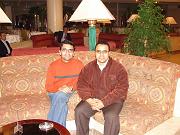 For the rest of our trip, we had multiple escorts, some times many at one time. If we strayed
from our
For the rest of our trip, we had multiple escorts, some times many at one time. If we strayed
from our
 well-defined path, we were to be reported to the 'Tourism Police' :). Hossam was one
sweet talker - Mayur was Ramses II and I was Queen Nefertari. And of course are we
Indians and did we know Amitabh Bacchan? I think about 75% of Egyptian people asked
us these questions. He showed us some key landmarks - the Alabaster Mohammed Ali
mosque, Aisha mosque, etc - along the way from the Heliopolis airport to our Mövenpick
hotel in Giza right near the Pyramids. There we got a big lecture from Hossam about how
we should tip all the people from his agency that we come in contact with in our trip,
which some how seemed like a third of Egypt :). We rested for a little bit in
our rooms. Then we strolled around our hotel, went to the rooftop cafe from where we
could get a view of the Pyramids. And then we went off to the see the 'Sound and Light
Show' at the Great Pyramids in Giza.
well-defined path, we were to be reported to the 'Tourism Police' :). Hossam was one
sweet talker - Mayur was Ramses II and I was Queen Nefertari. And of course are we
Indians and did we know Amitabh Bacchan? I think about 75% of Egyptian people asked
us these questions. He showed us some key landmarks - the Alabaster Mohammed Ali
mosque, Aisha mosque, etc - along the way from the Heliopolis airport to our Mövenpick
hotel in Giza right near the Pyramids. There we got a big lecture from Hossam about how
we should tip all the people from his agency that we come in contact with in our trip,
which some how seemed like a third of Egypt :). We rested for a little bit in
our rooms. Then we strolled around our hotel, went to the rooftop cafe from where we
could get a view of the Pyramids. And then we went off to the see the 'Sound and Light
Show' at the Great Pyramids in Giza.
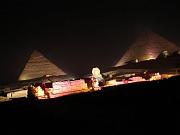
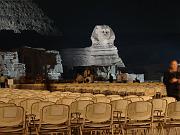 The Sound and Light Show
started around 6:30PM and lasted for about an hour. The Sphinx was the narrator
for the whole show. It talked about the history of the Pyramids, how many Pharaohs had
ruled over Egypt, built all these magnificent tombs, etc. Personally, the lighting was
excellent but the sound track was straight out of Cleopatra - a little too loud for
our taste :). We lingered around for a little bit after the show to take some nice
pictures; by the time we came out, Hossam was palpitating in fear of having to report
us to the Traffic Police.
The Sound and Light Show
started around 6:30PM and lasted for about an hour. The Sphinx was the narrator
for the whole show. It talked about the history of the Pyramids, how many Pharaohs had
ruled over Egypt, built all these magnificent tombs, etc. Personally, the lighting was
excellent but the sound track was straight out of Cleopatra - a little too loud for
our taste :). We lingered around for a little bit after the show to take some nice
pictures; by the time we came out, Hossam was palpitating in fear of having to report
us to the Traffic Police.

 He dropped us off at a local restaurant called Felfela which
has good wholesome Egyptian food such as tamia (felafel), hummus, and baba ganouge.
There were a bunch of people smoking water pipes which we didn't try that night but did
another time later. It was a good non-tourist trap place that we liked and went back to.
Notice the cool 'Capitchino' that they served there :). We
of course went for the local ahwa coffee instead.
We walked in and around the Giza area for a little bit after dinner before crashing back
at the hotel.
He dropped us off at a local restaurant called Felfela which
has good wholesome Egyptian food such as tamia (felafel), hummus, and baba ganouge.
There were a bunch of people smoking water pipes which we didn't try that night but did
another time later. It was a good non-tourist trap place that we liked and went back to.
Notice the cool 'Capitchino' that they served there :). We
of course went for the local ahwa coffee instead.
We walked in and around the Giza area for a little bit after dinner before crashing back
at the hotel.
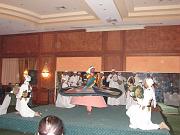 In the evening, there was some fancy party going on in our hotel that we
attended. We saw some local Sufi-type singers as well as whirling dervishes.
Those guys
just kept going round and round and round forever without getting tired. I suppose there
was no Maria to see if she could turn these dervishes out of whirl. With their
huge ghagra-like dresses billowing around it was looking very pretty and colorful; many
people from the audience joined them too. We waited around for a little bit to see
some belly dancing but were disappointed as that show went on way loner than when we were
ready to sleep.
In the evening, there was some fancy party going on in our hotel that we
attended. We saw some local Sufi-type singers as well as whirling dervishes.
Those guys
just kept going round and round and round forever without getting tired. I suppose there
was no Maria to see if she could turn these dervishes out of whirl. With their
huge ghagra-like dresses billowing around it was looking very pretty and colorful; many
people from the audience joined them too. We waited around for a little bit to see
some belly dancing but were disappointed as that show went on way loner than when we were
ready to sleep.
November 25, Saturday
What a spread for breakfast - an excellent way to start the day :). Most of the food
we ate during the entire trip was European as most of the tourist clientele in Egypt is
likewise. One must credit the Europeans with eating excellent breakfast at least. We
met our new tour director Yasser and our guide Noha. Our grand day visiting one of the
seven wonders of the world - the Great Pyramids of Giza. Noha explained to us how
they have to get a licence to become a tour guide; they study one language and the
history of the country - then they become guides in the language. Noha's English was
excellent and we had a good time with her story narration.
Our first stop were the step pyramids at Sakkara
which are located about 20 kms from
 the main Pyramids. These were the first pyramids that
the main Pyramids. These were the first pyramids that
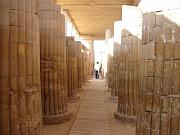 were built by Zoser, designed by his architect Imhotep (he really wasn't an evil guy at
all). The shape of the pyramids was thus chosen for two reasons - the conical top
resembled the sun rays emanating from the Sun God Amun-Ra, and the steps in the pyramid
would allow
the soul to climb the steps and ascend to the after-life. The pyramid itself is built
on the west side of the Nile to indicate the end of life just like the end of the day
when the sun sets in the west. Around the pyramids, we could see some of the restored
remains of a grand wall that surrounded the entire ancient necropolis of Memphis. All
these fancy tombs were located in Memphis. A colonnade of pillars
marks the entrance
to the tombs - they were beautiful fluted pillars made out of smoothed sandstone. We
walked around the campus and saw several other tombs of nobles and related royal family
were built by Zoser, designed by his architect Imhotep (he really wasn't an evil guy at
all). The shape of the pyramids was thus chosen for two reasons - the conical top
resembled the sun rays emanating from the Sun God Amun-Ra, and the steps in the pyramid
would allow
the soul to climb the steps and ascend to the after-life. The pyramid itself is built
on the west side of the Nile to indicate the end of life just like the end of the day
when the sun sets in the west. Around the pyramids, we could see some of the restored
remains of a grand wall that surrounded the entire ancient necropolis of Memphis. All
these fancy tombs were located in Memphis. A colonnade of pillars
marks the entrance
to the tombs - they were beautiful fluted pillars made out of smoothed sandstone. We
walked around the campus and saw several other tombs of nobles and related royal family
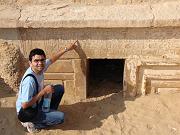
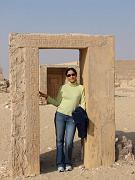 members with hieroglyphics all over them.
Behind the pyramid was a small closed grotto with a statue of the Pharaoh and two
holes in it for the king to smell the incense sticks that would be offered to him, and
to enable his soul to be released. The current statue is a pretty replica of the original
which was the only thing found in the pyramid after the tomb raiders (like Lara Croft,
so how did they glorify her to be good in the movie? Does she donate all the treasures
to the deserving governments for public consumption in museums?)
were done with it; the original statue is now in the Egyptian Museum of Antiquities in
Cairo. We also got a long view of the Red Pyramid and the Bent Pyramid at Dashur although
we did not visit them. We saw an unfinished burial chamber which had been dug deep into
the ground but was considered too small for the final coffin with all its paraphernalia
for after life so they dug a fresh new chamber and then built the pyramid on top of it.
members with hieroglyphics all over them.
Behind the pyramid was a small closed grotto with a statue of the Pharaoh and two
holes in it for the king to smell the incense sticks that would be offered to him, and
to enable his soul to be released. The current statue is a pretty replica of the original
which was the only thing found in the pyramid after the tomb raiders (like Lara Croft,
so how did they glorify her to be good in the movie? Does she donate all the treasures
to the deserving governments for public consumption in museums?)
were done with it; the original statue is now in the Egyptian Museum of Antiquities in
Cairo. We also got a long view of the Red Pyramid and the Bent Pyramid at Dashur although
we did not visit them. We saw an unfinished burial chamber which had been dug deep into
the ground but was considered too small for the final coffin with all its paraphernalia
for after life so they dug a fresh new chamber and then built the pyramid on top of it.
Our next stop was a carpet school.
We could actually see a few people actually weaving
the carpets right there - it was amazing - the speed at which the young girls were
knotting the carpets. Each knot is made by hand - no wonder the carpets are so expensive.
We also saw a bunch of carpets for sale - both silk and wool. Really liked one antique
bukhara but had no clue how to judge the price of $1800 so sadly had to let it go.
Then
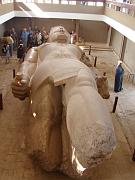 we visited the open-air museum of Memphis. The two star attractions there were a huge
we visited the open-air museum of Memphis. The two star attractions there were a huge
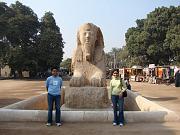 statue of Ramses II and the Alabaster Sphinx.
The Ramses statue was huge and occupied
the whole room lying on its back. Son of Seti I, Ramses II was THE man - he lived for
90+ years, ruled for 60+ years at the height of the glory of the Pharaohs,
had 50+ wives, and 150+ children :). His statue was a reflection of his
perfect self - a well-sculpted body, fancy headdress, cobra on the forehead for protection,
high cheekbones, pierced ears, fake beard, and a slight smile. He wears a short kilt with
a metallic belt with his 'cartouche' inscribed on it. A cartouche is a small oval
pendant-like thing in which the Pharaoh would inscribe his name in hieroglyphics. We saw
these cartouches all over on statues and in temples to indicate its builder. In the museum,
we also a triad of a God with his wife and a son - a common theme seen in many places
later on, albeit with different characters in the triad. The Alabaster Sphinx is presumed
to be of Queen Hatshepsut who ruled just like a king and united upper and lower Egypt. Most
of her cartouches were erased by her son when he became the king so it is hard to know for
sure if the sphinx belong to her. The sphinx was pretty and well-preserved.
statue of Ramses II and the Alabaster Sphinx.
The Ramses statue was huge and occupied
the whole room lying on its back. Son of Seti I, Ramses II was THE man - he lived for
90+ years, ruled for 60+ years at the height of the glory of the Pharaohs,
had 50+ wives, and 150+ children :). His statue was a reflection of his
perfect self - a well-sculpted body, fancy headdress, cobra on the forehead for protection,
high cheekbones, pierced ears, fake beard, and a slight smile. He wears a short kilt with
a metallic belt with his 'cartouche' inscribed on it. A cartouche is a small oval
pendant-like thing in which the Pharaoh would inscribe his name in hieroglyphics. We saw
these cartouches all over on statues and in temples to indicate its builder. In the museum,
we also a triad of a God with his wife and a son - a common theme seen in many places
later on, albeit with different characters in the triad. The Alabaster Sphinx is presumed
to be of Queen Hatshepsut who ruled just like a king and united upper and lower Egypt. Most
of her cartouches were erased by her son when he became the king so it is hard to know for
sure if the sphinx belong to her. The sphinx was pretty and well-preserved.
Last stop on the day tour were the
Great Pyramids of Giza. There are three main Pyramids
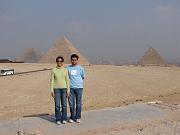 belonging respectively to King Khufu, King Khufren, and King Mesceranes - the father,
belonging respectively to King Khufu, King Khufren, and King Mesceranes - the father,
 the son, and the grandson (or nephew). These pyramids have absolutely smooth sloping
surfaces unlike the step pyramid of Sakkara. Now the top coating has worn away so we can
see the underlying stones but one can imagine the glory when they were built. There
must have been nothing around it and even today with a concrete jungle around it, one
is dwarfed by its size when one goes close to it. The
largest pyramid of King Khufu was
built using 2.5 million stones and put together without cement. And here it stands in
all its glory even today - perhaps some of the cheating builders in Pune can take a page
out of their builders' book :). Inside the biggest pyramid, there are three chambers - two were
left incomplete and the third one was finally used to keep the Pharaoh's coffin. We
went inside the Pyramid
- that was quite an experience. It was a super-narrow staircase
of about 100M to get to the burial chamber. As the ceiling was very low, we had to bend our
the son, and the grandson (or nephew). These pyramids have absolutely smooth sloping
surfaces unlike the step pyramid of Sakkara. Now the top coating has worn away so we can
see the underlying stones but one can imagine the glory when they were built. There
must have been nothing around it and even today with a concrete jungle around it, one
is dwarfed by its size when one goes close to it. The
largest pyramid of King Khufu was
built using 2.5 million stones and put together without cement. And here it stands in
all its glory even today - perhaps some of the cheating builders in Pune can take a page
out of their builders' book :). Inside the biggest pyramid, there are three chambers - two were
left incomplete and the third one was finally used to keep the Pharaoh's coffin. We
went inside the Pyramid
- that was quite an experience. It was a super-narrow staircase
of about 100M to get to the burial chamber. As the ceiling was very low, we had to bend our
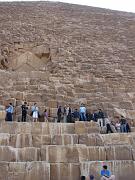 backs to climb up and down. There were only two air shafts inside the final chamber so it
backs to climb up and down. There were only two air shafts inside the final chamber so it
 burial chamber as there is nothing to see there. It is totally amazing how the workers
buried the king, then sealed all the passages and escaped from hidden exits. The
archaeologists opened the pyramid from one particular location facing south (as the
entrances were supposed to face south) and then dug inside to find the final ascending
staircase to the burial chamber.
We drove around the whole complex and saw the other two pyramids too. The third and
smallest pyramid was the most expensive as it was totally covered in red granite stone.
We got a beautiful panoramic view of all three pyramids from a high ground near by.
There was also a small bazaar and camel rides there which we skipped :). You also get
a splendid view of the entire city as the entire pyramid complex is built on high
ground way above the old (and even the current) city. The big Pharaoh pyramids are
surrounded by smaller tombs of queens and noblemen.
Its only in India that the best tomb is for a woman :).
burial chamber as there is nothing to see there. It is totally amazing how the workers
buried the king, then sealed all the passages and escaped from hidden exits. The
archaeologists opened the pyramid from one particular location facing south (as the
entrances were supposed to face south) and then dug inside to find the final ascending
staircase to the burial chamber.
We drove around the whole complex and saw the other two pyramids too. The third and
smallest pyramid was the most expensive as it was totally covered in red granite stone.
We got a beautiful panoramic view of all three pyramids from a high ground near by.
There was also a small bazaar and camel rides there which we skipped :). You also get
a splendid view of the entire city as the entire pyramid complex is built on high
ground way above the old (and even the current) city. The big Pharaoh pyramids are
surrounded by smaller tombs of queens and noblemen.
Its only in India that the best tomb is for a woman :).
Last stop was the grand old dame - the Sphinx.
It is in a pretty damaged condition as
 it was made of a cheaper quality of stone. It was preserved for so long as it was totally
it was made of a cheaper quality of stone. It was preserved for so long as it was totally
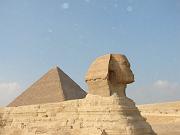 buried under the sand and not excavated until the beginning of the twentieth century.
The Sphinx is an image of God on earth with the face of the king for intelligence and
the body of a lion for power. Its beard was stolen by the British (as usual) and can
now be seen in the British Museum in London. Besides the sphinx, we can see the
three-stage building for the pyramid of Khufren - the valley temple where the high priests
perform rituals, the procession corridor, and the mortuary temple where the king is
mummified and then buried in the pyramid. While mummifying, they removed the heart,
lungs, stomach and intestines, and stored them in jars along with the dead body. They
threw away the brain as they believed that all good came from the heart and all bad
came from the brain. At the time of judgement, the heart was weighed against a feather:
if heavier the person was judged bad, otherwise good.
buried under the sand and not excavated until the beginning of the twentieth century.
The Sphinx is an image of God on earth with the face of the king for intelligence and
the body of a lion for power. Its beard was stolen by the British (as usual) and can
now be seen in the British Museum in London. Besides the sphinx, we can see the
three-stage building for the pyramid of Khufren - the valley temple where the high priests
perform rituals, the procession corridor, and the mortuary temple where the king is
mummified and then buried in the pyramid. While mummifying, they removed the heart,
lungs, stomach and intestines, and stored them in jars along with the dead body. They
threw away the brain as they believed that all good came from the heart and all bad
came from the brain. At the time of judgement, the heart was weighed against a feather:
if heavier the person was judged bad, otherwise good.
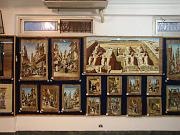 Inside the valley temple, we can see a pit
where the statue of the king was retrieved. Apparently there were 23 such statues,
one for each part of the body while counting double parts such as eyes and ears just
once. After the pyramids, we had lunch at a so-so place called Tivoli eating pretty much
salads and desserts as there were no vegetarian main courses. We also visited a
Papyrus Museum
with beautiful paintings on papyrus. The shopkeeper also showed us how they use
the papyrus plant to make paper - they peel the stalk and cut it into thin strips.
They remove the water from the strips and then align them in a grid fashion. Then
based on the darkness of color required, the papyrus is pressed for a certain duration
of time and then painted over.
Inside the valley temple, we can see a pit
where the statue of the king was retrieved. Apparently there were 23 such statues,
one for each part of the body while counting double parts such as eyes and ears just
once. After the pyramids, we had lunch at a so-so place called Tivoli eating pretty much
salads and desserts as there were no vegetarian main courses. We also visited a
Papyrus Museum
with beautiful paintings on papyrus. The shopkeeper also showed us how they use
the papyrus plant to make paper - they peel the stalk and cut it into thin strips.
They remove the water from the strips and then align them in a grid fashion. Then
based on the darkness of color required, the papyrus is pressed for a certain duration
of time and then painted over.
In the evening, we asked to be dropped off in Cairo - our one cool evening with no escorts.
We started
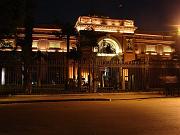 off in Midan Tahrir - Liberation Square where we saw the big hotels like the Hilton,
Semiramis, the muqama building,
the Egyptian Museum of Antiquities, etc. We struggled to
make one phone call to Hossam as random people kept giving us their visiting cards :).
off in Midan Tahrir - Liberation Square where we saw the big hotels like the Hilton,
Semiramis, the muqama building,
the Egyptian Museum of Antiquities, etc. We struggled to
make one phone call to Hossam as random people kept giving us their visiting cards :).
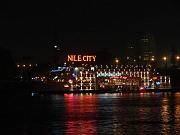 After haggling around, we finally managed to find a place to call him. We walked along
the Nile for a little bit - very peaceful - and also climbed to the roof top cafe at
the Nile Hilton where we got excellent views of the Nile
and the entire city of Cairo.
We had coffee and pastries at a local coffee shop - Grobbi. We also
tried really hard to take a bus back to our hotel with no luck :(. We managed to find
the bus stop and the bus number but we could not read the Arabic numerals on the
buses. Surprisingly no one at the bus stop spoke English - and the one guy who could,
was surprised that we were taking a bus and just asked us to take a taxi :). It was
a terribly interesting taxi drive too as the driver totally did not understand English.
Somehow we managed to draw circles in the air and explain to him where we wanted to go.
At one point we asked him how much longer it would take to get to the hotel, and he
said 50 minutes as in 11, 12, 13, 14, 50 :). Ate a quiet dinner at the hotel as we
were quite tired.
After haggling around, we finally managed to find a place to call him. We walked along
the Nile for a little bit - very peaceful - and also climbed to the roof top cafe at
the Nile Hilton where we got excellent views of the Nile
and the entire city of Cairo.
We had coffee and pastries at a local coffee shop - Grobbi. We also
tried really hard to take a bus back to our hotel with no luck :(. We managed to find
the bus stop and the bus number but we could not read the Arabic numerals on the
buses. Surprisingly no one at the bus stop spoke English - and the one guy who could,
was surprised that we were taking a bus and just asked us to take a taxi :). It was
a terribly interesting taxi drive too as the driver totally did not understand English.
Somehow we managed to draw circles in the air and explain to him where we wanted to go.
At one point we asked him how much longer it would take to get to the hotel, and he
said 50 minutes as in 11, 12, 13, 14, 50 :). Ate a quiet dinner at the hotel as we
were quite tired.
November 26, Sunday
Day in Cairo! We first drove to the
Egyptian Museum of Antiquities with its rare blue
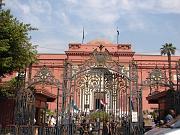 lotuses in the front pond. We could not take any pictures inside the museum so that
flash photography does not destroy the antiques, because people should have to come
to Cairo to see these treasures, and because people should buy their postcards for
memories :). The museum has some beautiful artifacts and I really wished that we
could have seen all the treasures over the 30 decades of Pharaoh rule but most of
the treasures had been stolen from the tombs themselves either by the tomb builders
(having not being paid properly for its construction), tombs robbers or
greedy archaeologists. The first floor of the museum had antiquities from many
different ages of Egypt while the second floor was all about Tut-Ankh-Amun's
treasures. He was a boy king and ruled from 9-19 years of age. He died suddenly
either from gangrene in a leg broken during a riding expedition or due to a
treacherous blow to his head. Since he was young, he had not yet started to built his
fancy tomb so they just used a sidey high priest's tomb for the burial. As a result
the tomb went unnoticed and unrobbed. Further, another king built his tomb on top
of Tut's tomb so it was protected until the 1920's when it was found intact with
all its treasures. We saw some of these treasures in the museum - he was encased
in 12 different layers: the innermost ones were the typical white tape that we
imagine mummies in, followed by anthropoid coffins, and finally the main box-shaped
coffins. All these are present in the museum - the anthropoid coffins are either
gold or gilded - simply beautiful. But the cherry on the cake is the solid gold 10kg
mask of Tut - it is just mind-blowing. We went by it several times to soak it in. Other
treasures found included jewelry as well as funeral beds with animals as bed posts to
guard the king. Other statues that we saw included a primitive one of King Zosser
and one of King Khufren made of Eurite which was found in the valley temple near
the great pyramids. We also saw the original statue of King Zosser from the Sakkara
pyramid whose replica is now present at the pyramid. There was a very 6-inch statue
of King Khufu also found in the great pyramids - the head and body were separated from
each other and hence not found by robbers. The archaeologists also found the two parts
three weeks apart and then joined them together. There was a special room dedicated
to the real mummies but Mayur had seen such mummies earlier in London so we weren't
very interested in them; instead we saw some animal mummies. There was huge atrium
in the middle of the museum on the first floor with huge statues of King Ramses, King
Akhanten's parents (especially his mother who was the cause of some friction between him
and his wife),
King Akhnaten and his wife Nefertiti who was the mother, aunt, and mother-in-law
of King Tut :). Basically she was Akhnaten's sister and Tut married her daughter. The
practice of marrying one's sibling was very common to ensure that the throne remained in
the family but with modern genetic studies, perhaps it led to weaker kings and led to
their eventual destruction by other races and tribes.
Akhnaten's statues are more realistic than Ramses and portray his real posture rather
than an ideal one. He also had a different philosophy and worshipped other gods than
the earlier Pharaohs - Tut followed him but only for some time before reverting back
to the old practices. One common theme all over the museum was the representation of
the unification of Upper and Lower Egypt: using a papyrus and lotus plants to represent
the two regions or the white and red crowns of the respective kings. We also saw some
jewelry of the queens of King Khufu found in the smaller tombs around the great
pyramids. A very enjoyable experience but I really wish more of these wonderful
treasures could have been preserved.
lotuses in the front pond. We could not take any pictures inside the museum so that
flash photography does not destroy the antiques, because people should have to come
to Cairo to see these treasures, and because people should buy their postcards for
memories :). The museum has some beautiful artifacts and I really wished that we
could have seen all the treasures over the 30 decades of Pharaoh rule but most of
the treasures had been stolen from the tombs themselves either by the tomb builders
(having not being paid properly for its construction), tombs robbers or
greedy archaeologists. The first floor of the museum had antiquities from many
different ages of Egypt while the second floor was all about Tut-Ankh-Amun's
treasures. He was a boy king and ruled from 9-19 years of age. He died suddenly
either from gangrene in a leg broken during a riding expedition or due to a
treacherous blow to his head. Since he was young, he had not yet started to built his
fancy tomb so they just used a sidey high priest's tomb for the burial. As a result
the tomb went unnoticed and unrobbed. Further, another king built his tomb on top
of Tut's tomb so it was protected until the 1920's when it was found intact with
all its treasures. We saw some of these treasures in the museum - he was encased
in 12 different layers: the innermost ones were the typical white tape that we
imagine mummies in, followed by anthropoid coffins, and finally the main box-shaped
coffins. All these are present in the museum - the anthropoid coffins are either
gold or gilded - simply beautiful. But the cherry on the cake is the solid gold 10kg
mask of Tut - it is just mind-blowing. We went by it several times to soak it in. Other
treasures found included jewelry as well as funeral beds with animals as bed posts to
guard the king. Other statues that we saw included a primitive one of King Zosser
and one of King Khufren made of Eurite which was found in the valley temple near
the great pyramids. We also saw the original statue of King Zosser from the Sakkara
pyramid whose replica is now present at the pyramid. There was a very 6-inch statue
of King Khufu also found in the great pyramids - the head and body were separated from
each other and hence not found by robbers. The archaeologists also found the two parts
three weeks apart and then joined them together. There was a special room dedicated
to the real mummies but Mayur had seen such mummies earlier in London so we weren't
very interested in them; instead we saw some animal mummies. There was huge atrium
in the middle of the museum on the first floor with huge statues of King Ramses, King
Akhanten's parents (especially his mother who was the cause of some friction between him
and his wife),
King Akhnaten and his wife Nefertiti who was the mother, aunt, and mother-in-law
of King Tut :). Basically she was Akhnaten's sister and Tut married her daughter. The
practice of marrying one's sibling was very common to ensure that the throne remained in
the family but with modern genetic studies, perhaps it led to weaker kings and led to
their eventual destruction by other races and tribes.
Akhnaten's statues are more realistic than Ramses and portray his real posture rather
than an ideal one. He also had a different philosophy and worshipped other gods than
the earlier Pharaohs - Tut followed him but only for some time before reverting back
to the old practices. One common theme all over the museum was the representation of
the unification of Upper and Lower Egypt: using a papyrus and lotus plants to represent
the two regions or the white and red crowns of the respective kings. We also saw some
jewelry of the queens of King Khufu found in the smaller tombs around the great
pyramids. A very enjoyable experience but I really wish more of these wonderful
treasures could have been preserved.
After the museum, we had lunch at Al Saraya
- a floating restaurant on the Nile. This
place arguably had the best non-Egyptian food we had in Egypt. It was located right along
the Nile banks and we got lovely views of the river and the city while eating lunch. A
mighty fancy boat from inside too!
From there, we went to
the Citadel of Salah Din which used to be the seat of power for the Mamluks and Pashas.
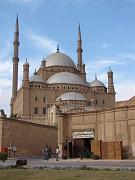 Within its walls is enclosed the beautiful
Alabaster Mosque of Mohammed Ali - the Pasha
Within its walls is enclosed the beautiful
Alabaster Mosque of Mohammed Ali - the Pasha
 not Cassius Clay as some Americans had earlier asked our guide Noha :). Mohammed Ali
Pasha was an Albanian in the Turkish army during the Ottoman empire and was sent to
rule over Egypt. He was largely responsible for the modernization of Egypt. This mosque
took 27 years to complete; the outer courtyard has a clock which was received from
France in exchange for an obelisk of Queen Hatshepsut - unfortunately the clock
has never worked :(.
Inside the mosque there are a million lights
which are spectacular. It also has one
main dome, four side domes and four quarter domes, all beautifully painted from inside. As the
citadel is located at a height, you get awesome views of Cairo city from here too. One
notorious story about the Pasha - he invited his rivals to dinner one day and destroyed
all the members of their clan thus ensuring his stronghold on the throne. So beware of
dinner invitations to the Citadel!
not Cassius Clay as some Americans had earlier asked our guide Noha :). Mohammed Ali
Pasha was an Albanian in the Turkish army during the Ottoman empire and was sent to
rule over Egypt. He was largely responsible for the modernization of Egypt. This mosque
took 27 years to complete; the outer courtyard has a clock which was received from
France in exchange for an obelisk of Queen Hatshepsut - unfortunately the clock
has never worked :(.
Inside the mosque there are a million lights
which are spectacular. It also has one
main dome, four side domes and four quarter domes, all beautifully painted from inside. As the
citadel is located at a height, you get awesome views of Cairo city from here too. One
notorious story about the Pasha - he invited his rivals to dinner one day and destroyed
all the members of their clan thus ensuring his stronghold on the throne. So beware of
dinner invitations to the Citadel!
We then spent some time in Old Islamic Cairo. First we visited the
Khan-El-Khalili bazaar

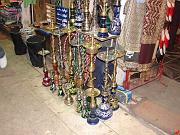 with its little shops, lots of wares, and plenty of haggling. It had a beautiful
collection of sheeshas or water-pipes.
Extremely similar to Tulshi Baug in Pune - a
novelty for people from developed countries I suppose.
It was THE only place in Egypt where someone
recognized our Google apparel and commented on the utility of the internet - it made
with its little shops, lots of wares, and plenty of haggling. It had a beautiful
collection of sheeshas or water-pipes.
Extremely similar to Tulshi Baug in Pune - a
novelty for people from developed countries I suppose.
It was THE only place in Egypt where someone
recognized our Google apparel and commented on the utility of the internet - it made
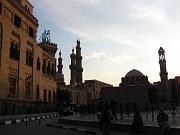
 Mayur's day for sure :). We walked around the area and saw a couple of other mosques:
the
Al-Azhar Mosque
and the Sultan Hassan Mosque. In general Cairo's skyline is dotted
with beautiful mosques - they are very peaceful from inside and a great place to spend
some introspective time. We had coffee at a local coffee shop called the
Naguib Mahfouz cafe named
after the famous Egyptian author of the same name. A very cute place and a great
stop for a break while walking through the Bazaar!
Mayur's day for sure :). We walked around the area and saw a couple of other mosques:
the
Al-Azhar Mosque
and the Sultan Hassan Mosque. In general Cairo's skyline is dotted
with beautiful mosques - they are very peaceful from inside and a great place to spend
some introspective time. We had coffee at a local coffee shop called the
Naguib Mahfouz cafe named
after the famous Egyptian author of the same name. A very cute place and a great
stop for a break while walking through the Bazaar!
We decided to play it safe this evening and had our driver drop us back to the hotel
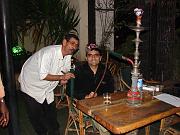
 instead of trying out local transport. At night, we went back to Felfela for dinner.
This time we tried ahwa - Turkish coffee with 'mazboot' amounts of sugar. It was quite
thick and strong but Mayur liked it nonetheless. Italy still takes the top place for
excellent coffee :). We also took a shot at the sheeshas
or water pipes - the only time either of
us have ever attempted to smoke. It was more of a photo-op for which the waiters there
gracefully obliged us upon getting a little 'baksheesh'. Imagine my surprise when I went
to India and saw that we have a similar cafe in Pune where one can smoke a sheesha,
albeit without tobacco! Globalization man! We crashed in early foregoing
the hotel party as we had yet another early-morning departure the next day.
instead of trying out local transport. At night, we went back to Felfela for dinner.
This time we tried ahwa - Turkish coffee with 'mazboot' amounts of sugar. It was quite
thick and strong but Mayur liked it nonetheless. Italy still takes the top place for
excellent coffee :). We also took a shot at the sheeshas
or water pipes - the only time either of
us have ever attempted to smoke. It was more of a photo-op for which the waiters there
gracefully obliged us upon getting a little 'baksheesh'. Imagine my surprise when I went
to India and saw that we have a similar cafe in Pune where one can smoke a sheesha,
albeit without tobacco! Globalization man! We crashed in early foregoing
the hotel party as we had yet another early-morning departure the next day.
November 27, Monday
 A long day at Luxor. We started off around 2:30AM to catch our ridiculously early 5AM flight.
Our hotel party was still going strong and we saw a few minutes of
belly dancing. Hmm,
I am sure it can be done more tastefully but it was interesting to watch it nonetheless.
We got royal treatment at the airport and were automatically transported to the gate
without having to check in luggage or collect our boarding passes ourselves - we were
being spoon-fed all the time :). After a short one-hour flight to Luxor with food
service (it appears that all airlines around the world except in US believe in feeding
people), we were greeted at the airport by our super-cool guide Mohammed. Now his
proficiency is in Italian so he kept sounding to us more like an Italian than an
Egyptian :). We also met our co-traveler for the rest of the Journey - Scott from Florida.
He was with us for the cruise as well as our trip in Alexandria.
A long day at Luxor. We started off around 2:30AM to catch our ridiculously early 5AM flight.
Our hotel party was still going strong and we saw a few minutes of
belly dancing. Hmm,
I am sure it can be done more tastefully but it was interesting to watch it nonetheless.
We got royal treatment at the airport and were automatically transported to the gate
without having to check in luggage or collect our boarding passes ourselves - we were
being spoon-fed all the time :). After a short one-hour flight to Luxor with food
service (it appears that all airlines around the world except in US believe in feeding
people), we were greeted at the airport by our super-cool guide Mohammed. Now his
proficiency is in Italian so he kept sounding to us more like an Italian than an
Egyptian :). We also met our co-traveler for the rest of the Journey - Scott from Florida.
He was with us for the cruise as well as our trip in Alexandria.
Our first stop in Luxor was the Valley of Kings. This valley
has 62 tombs, and only recently they discovered the 63rd tomb with 8
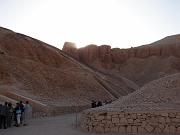
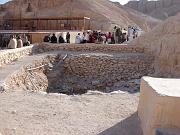 sarcophagi but no mummies inside it. This last tomb
was probably used a storage room to avoid
any robberies. All the tombs are on the west side of the Nile to symbolize the setting of
the sun and the end of life.
We saw three tombs there - all of King Ramses (followed by some number or
the other). Each tomb had a steep descent
to the final sarcophagus; the steps were lined
with walls painted with the most amazing colors that can still be seen even today! Tombs
also had false chambers to dissuade robbers. There were three different kingdoms in
ancient Egypt - the Old Kingdom where the pharaohs built the pompous Great Pyramid tombs
which were
very easily robbed. To overcome this problem, the Middle Kingdom kings built complicated
sarcophagi but no mummies inside it. This last tomb
was probably used a storage room to avoid
any robberies. All the tombs are on the west side of the Nile to symbolize the setting of
the sun and the end of life.
We saw three tombs there - all of King Ramses (followed by some number or
the other). Each tomb had a steep descent
to the final sarcophagus; the steps were lined
with walls painted with the most amazing colors that can still be seen even today! Tombs
also had false chambers to dissuade robbers. There were three different kingdoms in
ancient Egypt - the Old Kingdom where the pharaohs built the pompous Great Pyramid tombs
which were
very easily robbed. To overcome this problem, the Middle Kingdom kings built complicated
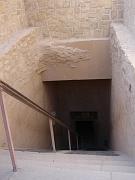
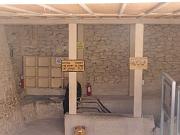 inner chambers in their tombs such as the Bent and Red Pyramids in Dashur, near Cairo.
The New Kingdom kings built the hidden tombs in the Valley of the Kings - alas, none of
these precautions worked and all the tombs were robbed nonetheless.
King Tut-Ankh-Amun's tomb
was found by British archaeologist Carter from 1917 to 1922 in the Valley of the Kings.
It was extremely well-preserved because it was hidden by another king's tomb. The mummy
is still in situ as it is too damaged to be moved to a museum. Carter stayed on site in
a house right outside the valley for nearly 17 years! After the Valley of Kings, we visited
a factory store where they manufacture alabaster and green onyx artifacts. It was interesting
to see it but we did not buy anything.
inner chambers in their tombs such as the Bent and Red Pyramids in Dashur, near Cairo.
The New Kingdom kings built the hidden tombs in the Valley of the Kings - alas, none of
these precautions worked and all the tombs were robbed nonetheless.
King Tut-Ankh-Amun's tomb
was found by British archaeologist Carter from 1917 to 1922 in the Valley of the Kings.
It was extremely well-preserved because it was hidden by another king's tomb. The mummy
is still in situ as it is too damaged to be moved to a museum. Carter stayed on site in
a house right outside the valley for nearly 17 years! After the Valley of Kings, we visited
a factory store where they manufacture alabaster and green onyx artifacts. It was interesting
to see it but we did not buy anything.
Our next stop in Luxor was Queen Hatshepsut's temple
- she was one of the most famous queens
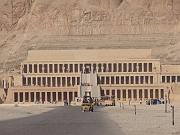
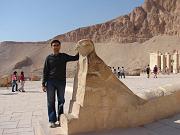 to rule Egypt. She was the daughter of Tutmoses I - the first king to be buried in the Valley
of the Kings. She married her brother Tutmoses II but could not bear a son (faint resemblances
to the current state of the Japanese monarchy - so archaic!). So the king had a son with a
commoner. After he died, Hatshepsut wanted to become the queen but there were two hurdles which
she overcame: (1) she sent away the son Tutmoses III to Memphis after only two years of rule,
and (2) she proclaimed to be the daughter of the Sun God Amun to allow her to rule even though
she was a woman. She reigned for 20 years and it was a peaceful time with no wars. She built
to rule Egypt. She was the daughter of Tutmoses I - the first king to be buried in the Valley
of the Kings. She married her brother Tutmoses II but could not bear a son (faint resemblances
to the current state of the Japanese monarchy - so archaic!). So the king had a son with a
commoner. After he died, Hatshepsut wanted to become the queen but there were two hurdles which
she overcame: (1) she sent away the son Tutmoses III to Memphis after only two years of rule,
and (2) she proclaimed to be the daughter of the Sun God Amun to allow her to rule even though
she was a woman. She reigned for 20 years and it was a peaceful time with no wars. She built
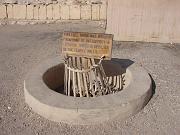
 this temple is honor of Amun - it has three floors. The murals on the first floor were totally
destroyed. The second floor explains the story of her birth and how she got
cedar plants from Somalia
for the temple. The topmost floor has the sanctum sanctorum originally made of granite
where only the queen and her high priest were allowed. The queen respected her workers and
allowed them built their tombs around this temple.
In the ancient days, the Nile came right
up to the foot of the temple which was also surrounded by lush green lawns, of course no more.
this temple is honor of Amun - it has three floors. The murals on the first floor were totally
destroyed. The second floor explains the story of her birth and how she got
cedar plants from Somalia
for the temple. The topmost floor has the sanctum sanctorum originally made of granite
where only the queen and her high priest were allowed. The queen respected her workers and
allowed them built their tombs around this temple.
In the ancient days, the Nile came right
up to the foot of the temple which was also surrounded by lush green lawns, of course no more.
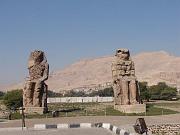
 The last stop before lunch was the Colossi of Memnon.
These two massive statues were built
as protectors of the temple of King Ramses II. No remains of the temple have been found. Pieces
of these statues were found and reassembled by archaeologists. These statues make a hideous
sound when wind passes through them which was supposed to act as a deterrent to the spirits
in order to protect the king's temple. After the long morning, we headed straight for our
cruise ship - the Royal Princess. Since we were quite tired and had a long afternoon ahead of us,
we just left the exploration of the ship till the next morning. We ate lunch, rested for a bit,
and then set off again in the afternoon to see the Luxor and Karnak temples.
The last stop before lunch was the Colossi of Memnon.
These two massive statues were built
as protectors of the temple of King Ramses II. No remains of the temple have been found. Pieces
of these statues were found and reassembled by archaeologists. These statues make a hideous
sound when wind passes through them which was supposed to act as a deterrent to the spirits
in order to protect the king's temple. After the long morning, we headed straight for our
cruise ship - the Royal Princess. Since we were quite tired and had a long afternoon ahead of us,
we just left the exploration of the ship till the next morning. We ate lunch, rested for a bit,
and then set off again in the afternoon to see the Luxor and Karnak temples.

 Both the Luxor and the Karnak temples were simply spectacular - I can only imagine how magnificent
it must have looked when they had not been destroyed and everything was intact. The
Karnak temple was
huge as many pharaohs built new parts of it without destroying the older parts. But I personally
liked the compact Luxor temple much more. Both are very similar in pattern and design.
We first went to the Karnak Temple. It has a huge wall - pylon
- at the entrance to ward off all enemies.
Right outside the main wall is a long avenue with sphinx statues on either side; in
ancient times, this avenue extended right up to the Luxor temple. This avenue honored the procession
of God Amun Ra who would visit the temple via his boat from the Nile. The entire temple complex
Both the Luxor and the Karnak temples were simply spectacular - I can only imagine how magnificent
it must have looked when they had not been destroyed and everything was intact. The
Karnak temple was
huge as many pharaohs built new parts of it without destroying the older parts. But I personally
liked the compact Luxor temple much more. Both are very similar in pattern and design.
We first went to the Karnak Temple. It has a huge wall - pylon
- at the entrance to ward off all enemies.
Right outside the main wall is a long avenue with sphinx statues on either side; in
ancient times, this avenue extended right up to the Luxor temple. This avenue honored the procession
of God Amun Ra who would visit the temple via his boat from the Nile. The entire temple complex
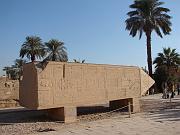
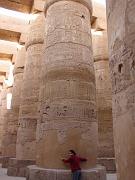 is dedicated to the triad of God Amun Ra, Goddess Mut, and their son Khonsu. There are two
obelisks of Queen Hatsepshut
- one is broken whereas one is completely intact as it was buried in the
sand for many years by her son Tutmoses III. The temple also had a huge
hypostyle hall with massive pillars.
These pillars totally dwarf any human! The whole complex was huge and very
impressive. Again, one can only imagine its glory at the height of the Egyptian empire. We spent
a lot of time walking around the temple but it was not enough. I could have spent a lot of more
time there just looking at all the ruins and hieroglyphics.
is dedicated to the triad of God Amun Ra, Goddess Mut, and their son Khonsu. There are two
obelisks of Queen Hatsepshut
- one is broken whereas one is completely intact as it was buried in the
sand for many years by her son Tutmoses III. The temple also had a huge
hypostyle hall with massive pillars.
These pillars totally dwarf any human! The whole complex was huge and very
impressive. Again, one can only imagine its glory at the height of the Egyptian empire. We spent
a lot of time walking around the temple but it was not enough. I could have spent a lot of more
time there just looking at all the ruins and hieroglyphics.

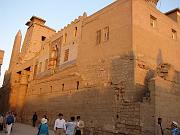 My personal favorite was Luxor Temple.
It was much smaller than the Karnak Temple but it
was very cozy and complete. It was buried under the sand for the longest time, and hence
well preserved. In fact, there is a
mosque which was built of top of this sand, and when
the Luxor temple was unearthed, the entrance to the mosque was suddenly several floors
higher than where it was originally built! A completely new entrance to the mosque had to
be built. This temple too had a huge pylon with a war scene engraved on the outside. The
idea was to scare away any enemies who would approach the temple with the power of this
painting. The inside of the wall had a huge religious relic painted on it. Outside of the
pylon is the continuation of the
Avenue of the Sphinxes from the Karnak Temple. The main
My personal favorite was Luxor Temple.
It was much smaller than the Karnak Temple but it
was very cozy and complete. It was buried under the sand for the longest time, and hence
well preserved. In fact, there is a
mosque which was built of top of this sand, and when
the Luxor temple was unearthed, the entrance to the mosque was suddenly several floors
higher than where it was originally built! A completely new entrance to the mosque had to
be built. This temple too had a huge pylon with a war scene engraved on the outside. The
idea was to scare away any enemies who would approach the temple with the power of this
painting. The inside of the wall had a huge religious relic painted on it. Outside of the
pylon is the continuation of the
Avenue of the Sphinxes from the Karnak Temple. The main

 entrance is flanked by an obelisk and two seated statues of Ramses II. This temple was
mainly built by Ramses II and Amenophis III. Some parts were reworked by Alexander the
Great and the Christians. We saw some artists restoring some of the damaged murals. Similar
to the Karnak Temple, we saw a huge colonnade hall with
statues of Ramses II and huge pillars.
All over there were symbols of the lotus and papyrus flowers indicating the union of
Upper and Lower Egypt. One obelisk from the entrance of this temple was exchanged for the
clock at the Alabaster Mosque in Cairo. The inner sanctum sanctorum of the temple has been
completely destroyed but there is the birth room of Amenophis II indicating how he was
the son of God (since he was not of royal blood) and the details of his birth. Since we
were too tired to now go for the Sound and Light show, we just had dinner and crashed
for the night.
entrance is flanked by an obelisk and two seated statues of Ramses II. This temple was
mainly built by Ramses II and Amenophis III. Some parts were reworked by Alexander the
Great and the Christians. We saw some artists restoring some of the damaged murals. Similar
to the Karnak Temple, we saw a huge colonnade hall with
statues of Ramses II and huge pillars.
All over there were symbols of the lotus and papyrus flowers indicating the union of
Upper and Lower Egypt. One obelisk from the entrance of this temple was exchanged for the
clock at the Alabaster Mosque in Cairo. The inner sanctum sanctorum of the temple has been
completely destroyed but there is the birth room of Amenophis II indicating how he was
the son of God (since he was not of royal blood) and the details of his birth. Since we
were too tired to now go for the Sound and Light show, we just had dinner and crashed
for the night.
November 28, Tuesday
This was a very peaceful relaxing day on the cruise.
Our cruise ship was really neat
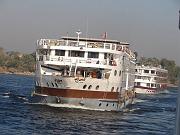
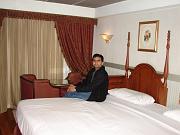 with about 50 rooms - it was a 5-star deluxe cruise. Apparently, the Egyptian Tourism
has deemed all ships as 5-star so one needs to take a deluxe cruise to get a better
boat. It was fully equipped with gym equipment, TT table, pool table, a fancy dining
room, a formal heavily-decorated main entrance hall, and a bar with a disco. As it was
the first cruise for both of us, we spent some time exploring the ship even though it
was quite small, . The staff was very courteous and every day we would see some cool
towel origami on our beds when we got back from sight-seeing.
with about 50 rooms - it was a 5-star deluxe cruise. Apparently, the Egyptian Tourism
has deemed all ships as 5-star so one needs to take a deluxe cruise to get a better
boat. It was fully equipped with gym equipment, TT table, pool table, a fancy dining
room, a formal heavily-decorated main entrance hall, and a bar with a disco. As it was
the first cruise for both of us, we spent some time exploring the ship even though it
was quite small, . The staff was very courteous and every day we would see some cool
towel origami on our beds when we got back from sight-seeing.
We set sail early in the morning

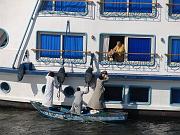 for Esna. On the way we had to cross the Esna lock,
and the ship was waiting for it
chance to do so. In the meanwhile we have a very
unique shopping experience - vendors
came by in little boats to sell their wares. From our rooms, we could easily reach
out and exchange stuff with them. For those of us on the topmost sun deck in the ship,
their innovative idea was to fling wares in plastic bags and we could examine them.
If we liked it, we could haggle on the top of our voices and either throw money back
in the bag or the wares. Since it was all duly wrapped in plastic, no damage was done.
Very interesting! Breakfast on the cruise was excellent. We found easy access to the
net every where along the cruise stops. We had lunch while parked at Esna and checked
email there as well as tried to make some changes to our flight plans. From Esna, we
sailed on to Edfu where again we checked email, had Turkish coffee and bought traditional
Egyptian Galabeya garbs for a party later on the cruise. We totally relaxed on the ship
the whole day reading our books, playing TT on the sun deck, having English-style tea
and pastries on the deck in the afternoon, and enjoying the local scenery on both
sides of the Nile. Caught a beautiful sunset on the Nile too. There was a disco party
at night that we attended for a short while. All in all a well-deserved welcome break!
for Esna. On the way we had to cross the Esna lock,
and the ship was waiting for it
chance to do so. In the meanwhile we have a very
unique shopping experience - vendors
came by in little boats to sell their wares. From our rooms, we could easily reach
out and exchange stuff with them. For those of us on the topmost sun deck in the ship,
their innovative idea was to fling wares in plastic bags and we could examine them.
If we liked it, we could haggle on the top of our voices and either throw money back
in the bag or the wares. Since it was all duly wrapped in plastic, no damage was done.
Very interesting! Breakfast on the cruise was excellent. We found easy access to the
net every where along the cruise stops. We had lunch while parked at Esna and checked
email there as well as tried to make some changes to our flight plans. From Esna, we
sailed on to Edfu where again we checked email, had Turkish coffee and bought traditional
Egyptian Galabeya garbs for a party later on the cruise. We totally relaxed on the ship
the whole day reading our books, playing TT on the sun deck, having English-style tea
and pastries on the deck in the afternoon, and enjoying the local scenery on both
sides of the Nile. Caught a beautiful sunset on the Nile too. There was a disco party
at night that we attended for a short while. All in all a well-deserved welcome break!
November 29, Wednesday
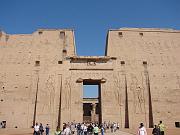
 We had an early breakfast and went off to see the
Temple of Horus - the falcon God - in Edfu.
We took a horse carriage
to the temple. Having ridden ghoda-gadis in India, it was no new
concept for Mayur and me. But I can see the appeal for people who may not have experienced
the ride before. Personally, I would have preferred to walk to the temple - get more of
a feel of the town. The temple was the most well-preserved one we saw. It was built by
the Greeks - Ptolemy XI and XII. The Greeks did not spend too much money on temples as
they always wanted to go back to Greece and take their money with them. So usually two kings
would build one temple. The
reliefs in the Edfu temple are very large and extremely clear.
We had an early breakfast and went off to see the
Temple of Horus - the falcon God - in Edfu.
We took a horse carriage
to the temple. Having ridden ghoda-gadis in India, it was no new
concept for Mayur and me. But I can see the appeal for people who may not have experienced
the ride before. Personally, I would have preferred to walk to the temple - get more of
a feel of the town. The temple was the most well-preserved one we saw. It was built by
the Greeks - Ptolemy XI and XII. The Greeks did not spend too much money on temples as
they always wanted to go back to Greece and take their money with them. So usually two kings
would build one temple. The
reliefs in the Edfu temple are very large and extremely clear.
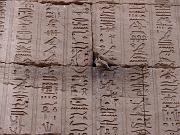
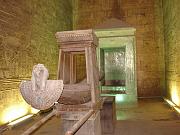 It had the second largest pylon after the Karnak temple, followed by 2 colonnade halls, and an
inner sanctorum. This sanctorum has a black granite sanctuary with a big statue of Horus
and a replica of Horus' barque. The huge pillars had beautiful lotus or papyrus engravings
on the top. Christians stayed in this temple to avoid persecution so they often lit huge
fires which have caused the ceilings to become black. The temple also has a Nilometer to
measure the rise of the Nile and the effective taxation rate of the people. This feature is absent
from Egyptian temples as the Pharaohs did not tax their citizens.
It had the second largest pylon after the Karnak temple, followed by 2 colonnade halls, and an
inner sanctorum. This sanctorum has a black granite sanctuary with a big statue of Horus
and a replica of Horus' barque. The huge pillars had beautiful lotus or papyrus engravings
on the top. Christians stayed in this temple to avoid persecution so they often lit huge
fires which have caused the ceilings to become black. The temple also has a Nilometer to
measure the rise of the Nile and the effective taxation rate of the people. This feature is absent
from Egyptian temples as the Pharaohs did not tax their citizens.
The story of Horus
is an interesting one. The Gods had two sets of twins: Seth and Isis,
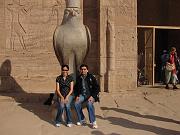
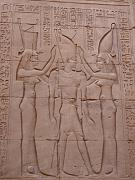 and Osiris and Nephetis. Seth married Nephetis and Isis married Osiris. But Seth was jealous
of Osiris as Isis was very beautiful. So he planned to kill him at a dinner party (as
the Mohammed Ali Pasha) thrown to celebrate the weddings. He made a sarcophagus to fit Osiris,
and played a game that the person who would fit in it would win the sarcophagus as a prize.
When Osiris tried it, Seth sealed the coffin and drowned it in the Nile. Then he also cut
the dead body into 14 pieces and distributed the pieces all over Egypt. Isis got very
upset and set off to look for her husband.
She left her son Horus with Hathor so he had two mothers. When
Horus grew up, he avenged his father's death by killing Seth. Reliefs in the temple show
Horus as a bull killing Seth, Ptolemy building the temple under the graces of Horus,
Horus' love for Hathor, Horus as a falcon above a lion indicating his power, etc.
and Osiris and Nephetis. Seth married Nephetis and Isis married Osiris. But Seth was jealous
of Osiris as Isis was very beautiful. So he planned to kill him at a dinner party (as
the Mohammed Ali Pasha) thrown to celebrate the weddings. He made a sarcophagus to fit Osiris,
and played a game that the person who would fit in it would win the sarcophagus as a prize.
When Osiris tried it, Seth sealed the coffin and drowned it in the Nile. Then he also cut
the dead body into 14 pieces and distributed the pieces all over Egypt. Isis got very
upset and set off to look for her husband.
She left her son Horus with Hathor so he had two mothers. When
Horus grew up, he avenged his father's death by killing Seth. Reliefs in the temple show
Horus as a bull killing Seth, Ptolemy building the temple under the graces of Horus,
Horus' love for Hathor, Horus as a falcon above a lion indicating his power, etc.
After Edfu, we ate lunch and sailed to Kom Obo.
We took a tour of the innards of our boat.

 We met the old hoagie who was our captain :). And saw all the engines etc which Mayur
totally enjoyed watching. We saw the Kom Obo temple both by daylight as well as night, and it
was quite nice by the night. This temple is dedicated to Horus and the crocodile God Sobek.
The temple has two doors, and two sanctuaries for the two gods. It could have also served
as a hospital as there are engravings all over the temple to that effect. We saw some
mummified crocodiles too.
The temple had an Egyptian calendar
with 12 months, each with 30
days. The calendar shows the seasons of cultivation, flood, and harvest. It has five extra
days for the celebration of the harvest. In this temple, there was a
Nilometer like the Edfu temple, which was used to measure
the rise of the Nile.
In the evening, we had a nice Galabeya party in the evening. We all wore these Egyptian
clothes and ate lovely Egyptian food for a change. We all danced a lot and played a lot
of random games. In one of the games, I had to
dress Mayur up as a Mummy! I did a pretty
good job but didn't win the prize for the best Mummy :(.
November 30, Thursday
We met the old hoagie who was our captain :). And saw all the engines etc which Mayur
totally enjoyed watching. We saw the Kom Obo temple both by daylight as well as night, and it
was quite nice by the night. This temple is dedicated to Horus and the crocodile God Sobek.
The temple has two doors, and two sanctuaries for the two gods. It could have also served
as a hospital as there are engravings all over the temple to that effect. We saw some
mummified crocodiles too.
The temple had an Egyptian calendar
with 12 months, each with 30
days. The calendar shows the seasons of cultivation, flood, and harvest. It has five extra
days for the celebration of the harvest. In this temple, there was a
Nilometer like the Edfu temple, which was used to measure
the rise of the Nile.
In the evening, we had a nice Galabeya party in the evening. We all wore these Egyptian
clothes and ate lovely Egyptian food for a change. We all danced a lot and played a lot
of random games. In one of the games, I had to
dress Mayur up as a Mummy! I did a pretty
good job but didn't win the prize for the best Mummy :(.
November 30, Thursday
Our last day on the cruise and boy, was it busy! In competition with the first day on the cruise.
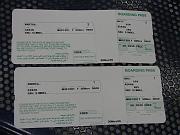 Overnight we sailed from Kom Obo to Aswan. We took an early morning flight to the temple of
Overnight we sailed from Kom Obo to Aswan. We took an early morning flight to the temple of
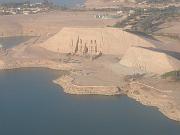 Abu Simbel which is an hour's flight from Aswan. We got totally
random boarding passes with our names
as Martha and Andrea :). It was basically a commuter plane that people were using like a
Greyhound bus. We got a beautiful view of the temple from the air
and Scott took a lovely
aerial shot of it. Along with seven other temples along the Nile, this temple was moved back from
its original location to prevent it from being submerged by Lake Nasser when the Aswan High Dam
was built. It took four years from 1964-68 and cost about $40 million. The facade of the temple
is very impressive with four statues of Ramses II, although was destroyed in an earthquake in the
early 20th century. Inside too, there are statues of Ramses in front of each pillar in the
Abu Simbel which is an hour's flight from Aswan. We got totally
random boarding passes with our names
as Martha and Andrea :). It was basically a commuter plane that people were using like a
Greyhound bus. We got a beautiful view of the temple from the air
and Scott took a lovely
aerial shot of it. Along with seven other temples along the Nile, this temple was moved back from
its original location to prevent it from being submerged by Lake Nasser when the Aswan High Dam
was built. It took four years from 1964-68 and cost about $40 million. The facade of the temple
is very impressive with four statues of Ramses II, although was destroyed in an earthquake in the
early 20th century. Inside too, there are statues of Ramses in front of each pillar in the
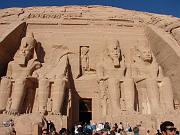 colonnade hall, and scenes of his valor while fighting. The inner sanctuary has four statues -
one of Ramses, and the others of Gods. These statues are fully lit only twice a year - on the
colonnade hall, and scenes of his valor while fighting. The inner sanctuary has four statues -
one of Ramses, and the others of Gods. These statues are fully lit only twice a year - on the
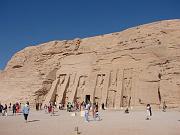 the coronation day of Ramses. Since they moved the temple, these dates were shifted by a
day. Even on these dates, the fourth statue of God of darkness always remains dark. The Abu
Simbel temple is located on a huge campus near Lake Nasser, and the less well-known temple in
that campus is Queen Nefertari's temple.
She was the favorite queen of Ramses so he built this
temple for her. The facade of this temple has six big statues of her and other gods and goddesses.
Inside there are scenes of Nefertari requesting Ramses to stop fighting, her being blessed by
Hathor, Hathor visiting her own temple in Denadra by a boat. The inner sanctuary was totally
destroyed as all the statues were completely covered in solid gold. After seeing this whole
beautiful complex, we flew back to Aswan. We took a long time to make some changes to our
return flight reservations and then had a quick lunch before heading out for more sight
seeing in the afternoon.
the coronation day of Ramses. Since they moved the temple, these dates were shifted by a
day. Even on these dates, the fourth statue of God of darkness always remains dark. The Abu
Simbel temple is located on a huge campus near Lake Nasser, and the less well-known temple in
that campus is Queen Nefertari's temple.
She was the favorite queen of Ramses so he built this
temple for her. The facade of this temple has six big statues of her and other gods and goddesses.
Inside there are scenes of Nefertari requesting Ramses to stop fighting, her being blessed by
Hathor, Hathor visiting her own temple in Denadra by a boat. The inner sanctuary was totally
destroyed as all the statues were completely covered in solid gold. After seeing this whole
beautiful complex, we flew back to Aswan. We took a long time to make some changes to our
return flight reservations and then had a quick lunch before heading out for more sight
seeing in the afternoon.
In the afternoon, our first stop was the Aswan Dam followed by the new
High Dam which was
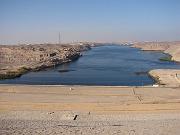
 built to prevent the Nile flooding to Cairo and above. Several temples were moved with
financial aid from UNESCO to prevent them from becoming submerged. We then visited one of
these moved temples - the temple of Isis at Philae.
It is located on an island so we took a motor boat to the temple. This temple
represents the event of Hathor celebrating Isis finding her husband Osiris. It was a
nice small temple much like some of the other big ones we saw in the trip earlier.
The Christians also built their own church there and we could see some signs of Christianity
in this old Pharaonic temple. There were many smaller monuments and temples around the
main temple of Isis including a beautiful birth chamber.
built to prevent the Nile flooding to Cairo and above. Several temples were moved with
financial aid from UNESCO to prevent them from becoming submerged. We then visited one of
these moved temples - the temple of Isis at Philae.
It is located on an island so we took a motor boat to the temple. This temple
represents the event of Hathor celebrating Isis finding her husband Osiris. It was a
nice small temple much like some of the other big ones we saw in the trip earlier.
The Christians also built their own church there and we could see some signs of Christianity
in this old Pharaonic temple. There were many smaller monuments and temples around the
main temple of Isis including a beautiful birth chamber.
We stopped at a perfume palace after the Philae Temple. They had the most aromatic
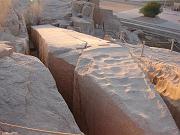 and therapeutic perfumes: mint, eucalyptus, lotus, papyrus, etc. And they also had
the most exquisite little glass bottles to keep the perfumes in. Even a single drop
of the concentrate perfume could spread a fragrance in the whole room - very nice!
and therapeutic perfumes: mint, eucalyptus, lotus, papyrus, etc. And they also had
the most exquisite little glass bottles to keep the perfumes in. Even a single drop
of the concentrate perfume could spread a fragrance in the whole room - very nice!
 After that, we saw the unfinished obelisk
- after being dug, the stone was found to
be too fragile and started to break. So they left the obelisk as it is. Our guide
explained that these obelisks were cut from all sides and then water was poured in
the cavity to lift it up. Wooden block were also used to help the process - I didn't
quite get how this all worked with such a heavy piece of stone! We then took a very
peaceful felucca (sailboat) ride
on the Nile - it was really the cherry on the cake
after the wonderful Nile cruise. Our boatman was a Nubian who are Egyptians that live
in the south. They have a practice that when a couple gets married, the groom stays
with the bride's family :). I totally enjoyed this ride - it was very soothing - I
wished we could have stayed longer. We bought some trinkets on the boat itself
- there is no getting away from shopping in Egypt! There was Nubian dance party on
the cruise at night but we crashed early on itself.
After that, we saw the unfinished obelisk
- after being dug, the stone was found to
be too fragile and started to break. So they left the obelisk as it is. Our guide
explained that these obelisks were cut from all sides and then water was poured in
the cavity to lift it up. Wooden block were also used to help the process - I didn't
quite get how this all worked with such a heavy piece of stone! We then took a very
peaceful felucca (sailboat) ride
on the Nile - it was really the cherry on the cake
after the wonderful Nile cruise. Our boatman was a Nubian who are Egyptians that live
in the south. They have a practice that when a couple gets married, the groom stays
with the bride's family :). I totally enjoyed this ride - it was very soothing - I
wished we could have stayed longer. We bought some trinkets on the boat itself
- there is no getting away from shopping in Egypt! There was Nubian dance party on
the cruise at night but we crashed early on itself.
December 1st, Friday
Last day in Egypt! Took the second-last of the early-morning flights back from Aswan
to Cairo. Before leaving the cruise, we sat on the sun deck for a little while before
the sun rose. It was so tranquil with all the lights along the Corniche De Nile
twinkling away! A highlight of the flight from Aswan to Cairo was that we got
a very good view of the pyramids at Memphis (the Bent
Pyramid and Red pyramid) which we had not seen from close. It was a very good
view from the left of the plane minutes before we hit the tarmac at Cairo.
At Cairo, we dropped off our luggage at the Sheraton and headed to
the Ramses train station for our train to Alexandria. There
we had this really interesting experience - three teenage Egyptian
girls came to me and asked me to take their 'photo'. I obliged them
thinking it was fun, and before I knew it they were asking me for 'money'! Never
quite got what happened there but it was interesting :). As there was still some time
for our train, we walked around Midan Ramses and saw another
beautiful mosque. We also
had excellent ahwa at the station coffee shop, and finally
boarded the train to Alexandria.
At Alexandria, we had the best of all our guides - Tamer. He was completely fluent in
English and very friendly. At first we went into the inner street of the city and I
found it very similar to Pune but after I saw the whole city, it was very much like
 Bombay. I liked the hubhub of Cairo but the marine drive at Alexandria took my breath
away. We first stopped at Pompeii's pillar
which was a part of the Greco-Roman ruins. Our guide - Tamer
- explained to us that all the monuments in Alexandria were destroyed due to the wars
between the Egyptians,
Greeks and Romans. The only thing remaining in this site was the pillar and three
Bombay. I liked the hubhub of Cairo but the marine drive at Alexandria took my breath
away. We first stopped at Pompeii's pillar
which was a part of the Greco-Roman ruins. Our guide - Tamer
- explained to us that all the monuments in Alexandria were destroyed due to the wars
between the Egyptians,
Greeks and Romans. The only thing remaining in this site was the pillar and three
 other sphinx statues. We then stopped at the Catacombs very similar to the ones
used by Christians in Italy to avoid persecution - unfortunately, no pictures
were allowed inside. It was a huge three-storey structure completely underground;
it was accidentally discovered when a local farmer's donkey feel through one of
the shafts. It was completely submerged under water when Alexandria was destroyed
either by a massive earthquake or a tsunami. The main shaft allows light to shine
through with holes to all the mummified corpses to be passed down. The third floor
is still totally submerged and has not been excavated. The architecture of this monument
is totally different from the other places as it was a mix of Greek, Roman, and Egyptian
architectures. Tombs are guarded by Greek symbols such as Medusa and serpents while
inside the tombs we see Egyptian gods such as Anubis and Isis albeit dressed in Greek
and Roman robes. Initially the catacombs were used only for a few wealthy families
but then they were opened up to bury the local people too. Now we can see hundreds of
niches to store as many mummies. There was one more big room in the catacombs named
Carcalla Hall after a king of the same name whom the Alexandrians did not like. He
had trapped many Alexandrians in one of the sectors in the city (named alpha, beta,
gamma, delta, and epsilon) and killed them all. A large number of bones were found in
Carcalla Hall which are believed to either belong to these people or to horses who
died in the Olympic games held in Alexandria. Another interesting practice was that
Roman used their bathtubs as future coffins. So they were made elaborately and when
the owner died, he was just buried in his bathtub :).
other sphinx statues. We then stopped at the Catacombs very similar to the ones
used by Christians in Italy to avoid persecution - unfortunately, no pictures
were allowed inside. It was a huge three-storey structure completely underground;
it was accidentally discovered when a local farmer's donkey feel through one of
the shafts. It was completely submerged under water when Alexandria was destroyed
either by a massive earthquake or a tsunami. The main shaft allows light to shine
through with holes to all the mummified corpses to be passed down. The third floor
is still totally submerged and has not been excavated. The architecture of this monument
is totally different from the other places as it was a mix of Greek, Roman, and Egyptian
architectures. Tombs are guarded by Greek symbols such as Medusa and serpents while
inside the tombs we see Egyptian gods such as Anubis and Isis albeit dressed in Greek
and Roman robes. Initially the catacombs were used only for a few wealthy families
but then they were opened up to bury the local people too. Now we can see hundreds of
niches to store as many mummies. There was one more big room in the catacombs named
Carcalla Hall after a king of the same name whom the Alexandrians did not like. He
had trapped many Alexandrians in one of the sectors in the city (named alpha, beta,
gamma, delta, and epsilon) and killed them all. A large number of bones were found in
Carcalla Hall which are believed to either belong to these people or to horses who
died in the Olympic games held in Alexandria. Another interesting practice was that
Roman used their bathtubs as future coffins. So they were made elaborately and when
the owner died, he was just buried in his bathtub :).
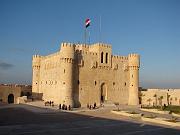
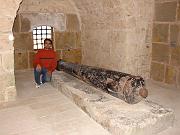 After the catacombs, we visited the Qaitbay fortress
located at the place of the old
Alexandria lighthouse - one of the seven wonders of the word - believed to be made of
solid gold and embedded with precious stones and gems. It was a legend that on a clear
day one could see Greece and Macedonia from the top of this famed lighthouse. The
fortress had a huge courtyard which was used for prayers as well as fighting practice.
Many techniques were used in the fortress to thwart the enemies - holes in the walls to
see enemies from afar, confusing corridors to mislead the enemies from the location of
the main tower, large-rise steps to make it hard to climb, pour oil from the holes in
the fortress walls, shoot flaming arrows from the shaft, narrow openings for archers
After the catacombs, we visited the Qaitbay fortress
located at the place of the old
Alexandria lighthouse - one of the seven wonders of the word - believed to be made of
solid gold and embedded with precious stones and gems. It was a legend that on a clear
day one could see Greece and Macedonia from the top of this famed lighthouse. The
fortress had a huge courtyard which was used for prayers as well as fighting practice.
Many techniques were used in the fortress to thwart the enemies - holes in the walls to
see enemies from afar, confusing corridors to mislead the enemies from the location of
the main tower, large-rise steps to make it hard to climb, pour oil from the holes in
the fortress walls, shoot flaming arrows from the shaft, narrow openings for archers
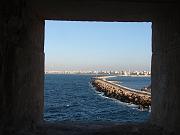
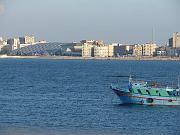 and canons
to shoot at the enemies but not get shot back at, etc. We got simply
spectacular views of the Mediterranean Sea and Alexandria (including the new
library of Alexandria) from the fortress. The fortress also had a
water reservoir, horse stables, dungeons, the works. We walked over to the sea and
dipped our feet there. It seems that Alexandrians consider themselves different from
other Egyptians; local harbor and tourism are the greatest sources of income in the city.
and canons
to shoot at the enemies but not get shot back at, etc. We got simply
spectacular views of the Mediterranean Sea and Alexandria (including the new
library of Alexandria) from the fortress. The fortress also had a
water reservoir, horse stables, dungeons, the works. We walked over to the sea and
dipped our feet there. It seems that Alexandrians consider themselves different from
other Egyptians; local harbor and tourism are the greatest sources of income in the city.
From the fortress, we drove along the marine drive to the new library. It was a magnificent
drive just like Bombay - just more modern, less crowded, and cleaner. I totally loved it -
Cairo got a 1 but Alexandria got a 1+ just based on this drive :).
Our last stop in Alexandria was the beautiful new library
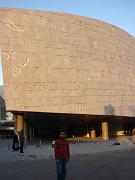 built in the same location (200 m away) as the ancient library of Alexandria which was the
first university and research center in the whole world. It had the equivalent of 125,000
books worth of material in papyrus scrolls, only one of which survived and a copy of it
is still in the new library. The original scroll is in a museum in Vienna.
built in the same location (200 m away) as the ancient library of Alexandria which was the
first university and research center in the whole world. It had the equivalent of 125,000
books worth of material in papyrus scrolls, only one of which survived and a copy of it
is still in the new library. The original scroll is in a museum in Vienna.
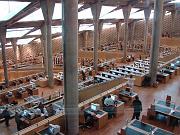 The library was totally submerged in the sea and there are
still 1200 pieces from the library under the sea. Tourists with licences to dive can
actually see these ancient underwater pieces. They had a competition to judge the best
design for the new library (just like the Sydney Opera House) which was won by a Norwegian.
The library resembles a sun rising from the water modeled as a pool outside the library.
Natural light is sufficient to light the whole library during the day. The outside facade
of the library has lines like eyelashes to indicate that the library has eyes open to the
whole world. It also has an incomplete bridge leading to the water indicating the
opening up of Egypt to the knowledge of the world. All terribly symbolic! The library has
the capacity to hold many many books but it is currently quite empty. It has nice exhibitions
of art direction for Egyptian movies and old/imagined pictures of ancient Alexandria. A
temporary exhibition showed the world's first printing presses. The library also has the eighth
largest planetarium in the world.
The library was totally submerged in the sea and there are
still 1200 pieces from the library under the sea. Tourists with licences to dive can
actually see these ancient underwater pieces. They had a competition to judge the best
design for the new library (just like the Sydney Opera House) which was won by a Norwegian.
The library resembles a sun rising from the water modeled as a pool outside the library.
Natural light is sufficient to light the whole library during the day. The outside facade
of the library has lines like eyelashes to indicate that the library has eyes open to the
whole world. It also has an incomplete bridge leading to the water indicating the
opening up of Egypt to the knowledge of the world. All terribly symbolic! The library has
the capacity to hold many many books but it is currently quite empty. It has nice exhibitions
of art direction for Egyptian movies and old/imagined pictures of ancient Alexandria. A
temporary exhibition showed the world's first printing presses. The library also has the eighth
largest planetarium in the world.
We had a lovely last dinner in Alexandria. We went to a restaurant right along marine drive
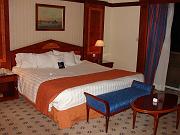
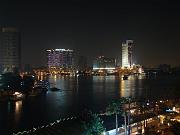 and had authentic Egyptian food. Tamer dropped off us at the station and reached Cairo after
a couple of hours. We got this super fancy suite in the Sheraton
for the night with a Nile
view but sadly I hardly had an hour there before I had to head back to the airport. We got
lovely view of Cairo city
by night from our room. Mayur and I sat in the patio for some time
soaking in the view and spending our last little time together - we were to meet after a long
month after that. Hossam dropped me off to the airport and I flew in to Bombay and Mayur flew
back the next day to San Francisco. I doubt if we will go back to Egypt but we had a great
time and its a must-see for all history buffs and otherwise too :).
and had authentic Egyptian food. Tamer dropped off us at the station and reached Cairo after
a couple of hours. We got this super fancy suite in the Sheraton
for the night with a Nile
view but sadly I hardly had an hour there before I had to head back to the airport. We got
lovely view of Cairo city
by night from our room. Mayur and I sat in the patio for some time
soaking in the view and spending our last little time together - we were to meet after a long
month after that. Hossam dropped me off to the airport and I flew in to Bombay and Mayur flew
back the next day to San Francisco. I doubt if we will go back to Egypt but we had a great
time and its a must-see for all history buffs and otherwise too :).
For the rest of our trip, we had multiple escorts, some times many at one time. If we strayed from our
well-defined path, we were to be reported to the 'Tourism Police' :). Hossam was one sweet talker - Mayur was Ramses II and I was Queen Nefertari. And of course are we Indians and did we know Amitabh Bacchan? I think about 75% of Egyptian people asked us these questions. He showed us some key landmarks - the Alabaster Mohammed Ali mosque, Aisha mosque, etc - along the way from the Heliopolis airport to our Mövenpick hotel in Giza right near the Pyramids. There we got a big lecture from Hossam about how we should tip all the people from his agency that we come in contact with in our trip, which some how seemed like a third of Egypt :). We rested for a little bit in our rooms. Then we strolled around our hotel, went to the rooftop cafe from where we could get a view of the Pyramids. And then we went off to the see the 'Sound and Light Show' at the Great Pyramids in Giza.

The Sound and Light Show started around 6:30PM and lasted for about an hour. The Sphinx was the narrator for the whole show. It talked about the history of the Pyramids, how many Pharaohs had ruled over Egypt, built all these magnificent tombs, etc. Personally, the lighting was excellent but the sound track was straight out of Cleopatra - a little too loud for our taste :). We lingered around for a little bit after the show to take some nice pictures; by the time we came out, Hossam was palpitating in fear of having to report us to the Traffic Police.

He dropped us off at a local restaurant called Felfela which has good wholesome Egyptian food such as tamia (felafel), hummus, and baba ganouge. There were a bunch of people smoking water pipes which we didn't try that night but did another time later. It was a good non-tourist trap place that we liked and went back to. Notice the cool 'Capitchino' that they served there :). We of course went for the local ahwa coffee instead. We walked in and around the Giza area for a little bit after dinner before crashing back at the hotel.
In the evening, there was some fancy party going on in our hotel that we attended. We saw some local Sufi-type singers as well as whirling dervishes. Those guys just kept going round and round and round forever without getting tired. I suppose there was no Maria to see if she could turn these dervishes out of whirl. With their huge ghagra-like dresses billowing around it was looking very pretty and colorful; many people from the audience joined them too. We waited around for a little bit to see some belly dancing but were disappointed as that show went on way loner than when we were ready to sleep.
the main Pyramids. These were the first pyramids that
were built by Zoser, designed by his architect Imhotep (he really wasn't an evil guy at all). The shape of the pyramids was thus chosen for two reasons - the conical top resembled the sun rays emanating from the Sun God Amun-Ra, and the steps in the pyramid would allow the soul to climb the steps and ascend to the after-life. The pyramid itself is built on the west side of the Nile to indicate the end of life just like the end of the day when the sun sets in the west. Around the pyramids, we could see some of the restored remains of a grand wall that surrounded the entire ancient necropolis of Memphis. All these fancy tombs were located in Memphis. A colonnade of pillars marks the entrance to the tombs - they were beautiful fluted pillars made out of smoothed sandstone. We walked around the campus and saw several other tombs of nobles and related royal family

members with hieroglyphics all over them. Behind the pyramid was a small closed grotto with a statue of the Pharaoh and two holes in it for the king to smell the incense sticks that would be offered to him, and to enable his soul to be released. The current statue is a pretty replica of the original which was the only thing found in the pyramid after the tomb raiders (like Lara Croft, so how did they glorify her to be good in the movie? Does she donate all the treasures to the deserving governments for public consumption in museums?) were done with it; the original statue is now in the Egyptian Museum of Antiquities in Cairo. We also got a long view of the Red Pyramid and the Bent Pyramid at Dashur although we did not visit them. We saw an unfinished burial chamber which had been dug deep into the ground but was considered too small for the final coffin with all its paraphernalia for after life so they dug a fresh new chamber and then built the pyramid on top of it.
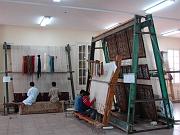
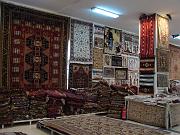

we visited the open-air museum of Memphis. The two star attractions there were a huge
statue of Ramses II and the Alabaster Sphinx. The Ramses statue was huge and occupied the whole room lying on its back. Son of Seti I, Ramses II was THE man - he lived for 90+ years, ruled for 60+ years at the height of the glory of the Pharaohs, had 50+ wives, and 150+ children :). His statue was a reflection of his perfect self - a well-sculpted body, fancy headdress, cobra on the forehead for protection, high cheekbones, pierced ears, fake beard, and a slight smile. He wears a short kilt with a metallic belt with his 'cartouche' inscribed on it. A cartouche is a small oval pendant-like thing in which the Pharaoh would inscribe his name in hieroglyphics. We saw these cartouches all over on statues and in temples to indicate its builder. In the museum, we also a triad of a God with his wife and a son - a common theme seen in many places later on, albeit with different characters in the triad. The Alabaster Sphinx is presumed to be of Queen Hatshepsut who ruled just like a king and united upper and lower Egypt. Most of her cartouches were erased by her son when he became the king so it is hard to know for sure if the sphinx belong to her. The sphinx was pretty and well-preserved.
belonging respectively to King Khufu, King Khufren, and King Mesceranes - the father,
the son, and the grandson (or nephew). These pyramids have absolutely smooth sloping surfaces unlike the step pyramid of Sakkara. Now the top coating has worn away so we can see the underlying stones but one can imagine the glory when they were built. There must have been nothing around it and even today with a concrete jungle around it, one is dwarfed by its size when one goes close to it. The largest pyramid of King Khufu was built using 2.5 million stones and put together without cement. And here it stands in all its glory even today - perhaps some of the cheating builders in Pune can take a page out of their builders' book :). Inside the biggest pyramid, there are three chambers - two were left incomplete and the third one was finally used to keep the Pharaoh's coffin. We went inside the Pyramid - that was quite an experience. It was a super-narrow staircase of about 100M to get to the burial chamber. As the ceiling was very low, we had to bend our
backs to climb up and down. There were only two air shafts inside the final chamber so it
burial chamber as there is nothing to see there. It is totally amazing how the workers buried the king, then sealed all the passages and escaped from hidden exits. The archaeologists opened the pyramid from one particular location facing south (as the entrances were supposed to face south) and then dug inside to find the final ascending staircase to the burial chamber. We drove around the whole complex and saw the other two pyramids too. The third and smallest pyramid was the most expensive as it was totally covered in red granite stone. We got a beautiful panoramic view of all three pyramids from a high ground near by. There was also a small bazaar and camel rides there which we skipped :). You also get a splendid view of the entire city as the entire pyramid complex is built on high ground way above the old (and even the current) city. The big Pharaoh pyramids are surrounded by smaller tombs of queens and noblemen. Its only in India that the best tomb is for a woman :).
it was made of a cheaper quality of stone. It was preserved for so long as it was totally
buried under the sand and not excavated until the beginning of the twentieth century. The Sphinx is an image of God on earth with the face of the king for intelligence and the body of a lion for power. Its beard was stolen by the British (as usual) and can now be seen in the British Museum in London. Besides the sphinx, we can see the three-stage building for the pyramid of Khufren - the valley temple where the high priests perform rituals, the procession corridor, and the mortuary temple where the king is mummified and then buried in the pyramid. While mummifying, they removed the heart, lungs, stomach and intestines, and stored them in jars along with the dead body. They threw away the brain as they believed that all good came from the heart and all bad came from the brain. At the time of judgement, the heart was weighed against a feather: if heavier the person was judged bad, otherwise good.
Inside the valley temple, we can see a pit where the statue of the king was retrieved. Apparently there were 23 such statues, one for each part of the body while counting double parts such as eyes and ears just once. After the pyramids, we had lunch at a so-so place called Tivoli eating pretty much salads and desserts as there were no vegetarian main courses. We also visited a Papyrus Museum with beautiful paintings on papyrus. The shopkeeper also showed us how they use the papyrus plant to make paper - they peel the stalk and cut it into thin strips. They remove the water from the strips and then align them in a grid fashion. Then based on the darkness of color required, the papyrus is pressed for a certain duration of time and then painted over.
off in Midan Tahrir - Liberation Square where we saw the big hotels like the Hilton, Semiramis, the muqama building, the Egyptian Museum of Antiquities, etc. We struggled to make one phone call to Hossam as random people kept giving us their visiting cards :).
After haggling around, we finally managed to find a place to call him. We walked along the Nile for a little bit - very peaceful - and also climbed to the roof top cafe at the Nile Hilton where we got excellent views of the Nile and the entire city of Cairo. We had coffee and pastries at a local coffee shop - Grobbi. We also tried really hard to take a bus back to our hotel with no luck :(. We managed to find the bus stop and the bus number but we could not read the Arabic numerals on the buses. Surprisingly no one at the bus stop spoke English - and the one guy who could, was surprised that we were taking a bus and just asked us to take a taxi :). It was a terribly interesting taxi drive too as the driver totally did not understand English. Somehow we managed to draw circles in the air and explain to him where we wanted to go. At one point we asked him how much longer it would take to get to the hotel, and he said 50 minutes as in 11, 12, 13, 14, 50 :). Ate a quiet dinner at the hotel as we were quite tired.
lotuses in the front pond. We could not take any pictures inside the museum so that flash photography does not destroy the antiques, because people should have to come to Cairo to see these treasures, and because people should buy their postcards for memories :). The museum has some beautiful artifacts and I really wished that we could have seen all the treasures over the 30 decades of Pharaoh rule but most of the treasures had been stolen from the tombs themselves either by the tomb builders (having not being paid properly for its construction), tombs robbers or greedy archaeologists. The first floor of the museum had antiquities from many different ages of Egypt while the second floor was all about Tut-Ankh-Amun's treasures. He was a boy king and ruled from 9-19 years of age. He died suddenly either from gangrene in a leg broken during a riding expedition or due to a treacherous blow to his head. Since he was young, he had not yet started to built his fancy tomb so they just used a sidey high priest's tomb for the burial. As a result the tomb went unnoticed and unrobbed. Further, another king built his tomb on top of Tut's tomb so it was protected until the 1920's when it was found intact with all its treasures. We saw some of these treasures in the museum - he was encased in 12 different layers: the innermost ones were the typical white tape that we imagine mummies in, followed by anthropoid coffins, and finally the main box-shaped coffins. All these are present in the museum - the anthropoid coffins are either gold or gilded - simply beautiful. But the cherry on the cake is the solid gold 10kg mask of Tut - it is just mind-blowing. We went by it several times to soak it in. Other treasures found included jewelry as well as funeral beds with animals as bed posts to guard the king. Other statues that we saw included a primitive one of King Zosser and one of King Khufren made of Eurite which was found in the valley temple near the great pyramids. We also saw the original statue of King Zosser from the Sakkara pyramid whose replica is now present at the pyramid. There was a very 6-inch statue of King Khufu also found in the great pyramids - the head and body were separated from each other and hence not found by robbers. The archaeologists also found the two parts three weeks apart and then joined them together. There was a special room dedicated to the real mummies but Mayur had seen such mummies earlier in London so we weren't very interested in them; instead we saw some animal mummies. There was huge atrium in the middle of the museum on the first floor with huge statues of King Ramses, King Akhanten's parents (especially his mother who was the cause of some friction between him and his wife), King Akhnaten and his wife Nefertiti who was the mother, aunt, and mother-in-law of King Tut :). Basically she was Akhnaten's sister and Tut married her daughter. The practice of marrying one's sibling was very common to ensure that the throne remained in the family but with modern genetic studies, perhaps it led to weaker kings and led to their eventual destruction by other races and tribes. Akhnaten's statues are more realistic than Ramses and portray his real posture rather than an ideal one. He also had a different philosophy and worshipped other gods than the earlier Pharaohs - Tut followed him but only for some time before reverting back to the old practices. One common theme all over the museum was the representation of the unification of Upper and Lower Egypt: using a papyrus and lotus plants to represent the two regions or the white and red crowns of the respective kings. We also saw some jewelry of the queens of King Khufu found in the smaller tombs around the great pyramids. A very enjoyable experience but I really wish more of these wonderful treasures could have been preserved.
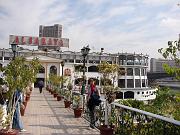

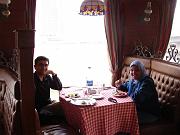
Within its walls is enclosed the beautiful Alabaster Mosque of Mohammed Ali - the Pasha
not Cassius Clay as some Americans had earlier asked our guide Noha :). Mohammed Ali Pasha was an Albanian in the Turkish army during the Ottoman empire and was sent to rule over Egypt. He was largely responsible for the modernization of Egypt. This mosque took 27 years to complete; the outer courtyard has a clock which was received from France in exchange for an obelisk of Queen Hatshepsut - unfortunately the clock has never worked :(. Inside the mosque there are a million lights which are spectacular. It also has one main dome, four side domes and four quarter domes, all beautifully painted from inside. As the citadel is located at a height, you get awesome views of Cairo city from here too. One notorious story about the Pasha - he invited his rivals to dinner one day and destroyed all the members of their clan thus ensuring his stronghold on the throne. So beware of dinner invitations to the Citadel!

with its little shops, lots of wares, and plenty of haggling. It had a beautiful collection of sheeshas or water-pipes. Extremely similar to Tulshi Baug in Pune - a novelty for people from developed countries I suppose. It was THE only place in Egypt where someone recognized our Google apparel and commented on the utility of the internet - it made

Mayur's day for sure :). We walked around the area and saw a couple of other mosques: the Al-Azhar Mosque and the Sultan Hassan Mosque. In general Cairo's skyline is dotted with beautiful mosques - they are very peaceful from inside and a great place to spend some introspective time. We had coffee at a local coffee shop called the Naguib Mahfouz cafe named after the famous Egyptian author of the same name. A very cute place and a great stop for a break while walking through the Bazaar!

instead of trying out local transport. At night, we went back to Felfela for dinner. This time we tried ahwa - Turkish coffee with 'mazboot' amounts of sugar. It was quite thick and strong but Mayur liked it nonetheless. Italy still takes the top place for excellent coffee :). We also took a shot at the sheeshas or water pipes - the only time either of us have ever attempted to smoke. It was more of a photo-op for which the waiters there gracefully obliged us upon getting a little 'baksheesh'. Imagine my surprise when I went to India and saw that we have a similar cafe in Pune where one can smoke a sheesha, albeit without tobacco! Globalization man! We crashed in early foregoing the hotel party as we had yet another early-morning departure the next day.
A long day at Luxor. We started off around 2:30AM to catch our ridiculously early 5AM flight. Our hotel party was still going strong and we saw a few minutes of belly dancing. Hmm, I am sure it can be done more tastefully but it was interesting to watch it nonetheless. We got royal treatment at the airport and were automatically transported to the gate without having to check in luggage or collect our boarding passes ourselves - we were being spoon-fed all the time :). After a short one-hour flight to Luxor with food service (it appears that all airlines around the world except in US believe in feeding people), we were greeted at the airport by our super-cool guide Mohammed. Now his proficiency is in Italian so he kept sounding to us more like an Italian than an Egyptian :). We also met our co-traveler for the rest of the Journey - Scott from Florida. He was with us for the cruise as well as our trip in Alexandria.

sarcophagi but no mummies inside it. This last tomb was probably used a storage room to avoid any robberies. All the tombs are on the west side of the Nile to symbolize the setting of the sun and the end of life. We saw three tombs there - all of King Ramses (followed by some number or the other). Each tomb had a steep descent to the final sarcophagus; the steps were lined with walls painted with the most amazing colors that can still be seen even today! Tombs also had false chambers to dissuade robbers. There were three different kingdoms in ancient Egypt - the Old Kingdom where the pharaohs built the pompous Great Pyramid tombs which were very easily robbed. To overcome this problem, the Middle Kingdom kings built complicated

inner chambers in their tombs such as the Bent and Red Pyramids in Dashur, near Cairo. The New Kingdom kings built the hidden tombs in the Valley of the Kings - alas, none of these precautions worked and all the tombs were robbed nonetheless. King Tut-Ankh-Amun's tomb was found by British archaeologist Carter from 1917 to 1922 in the Valley of the Kings. It was extremely well-preserved because it was hidden by another king's tomb. The mummy is still in situ as it is too damaged to be moved to a museum. Carter stayed on site in a house right outside the valley for nearly 17 years! After the Valley of Kings, we visited a factory store where they manufacture alabaster and green onyx artifacts. It was interesting to see it but we did not buy anything.

to rule Egypt. She was the daughter of Tutmoses I - the first king to be buried in the Valley of the Kings. She married her brother Tutmoses II but could not bear a son (faint resemblances to the current state of the Japanese monarchy - so archaic!). So the king had a son with a commoner. After he died, Hatshepsut wanted to become the queen but there were two hurdles which she overcame: (1) she sent away the son Tutmoses III to Memphis after only two years of rule, and (2) she proclaimed to be the daughter of the Sun God Amun to allow her to rule even though she was a woman. She reigned for 20 years and it was a peaceful time with no wars. She built

this temple is honor of Amun - it has three floors. The murals on the first floor were totally destroyed. The second floor explains the story of her birth and how she got cedar plants from Somalia for the temple. The topmost floor has the sanctum sanctorum originally made of granite where only the queen and her high priest were allowed. The queen respected her workers and allowed them built their tombs around this temple. In the ancient days, the Nile came right up to the foot of the temple which was also surrounded by lush green lawns, of course no more.

The last stop before lunch was the Colossi of Memnon. These two massive statues were built as protectors of the temple of King Ramses II. No remains of the temple have been found. Pieces of these statues were found and reassembled by archaeologists. These statues make a hideous sound when wind passes through them which was supposed to act as a deterrent to the spirits in order to protect the king's temple. After the long morning, we headed straight for our cruise ship - the Royal Princess. Since we were quite tired and had a long afternoon ahead of us, we just left the exploration of the ship till the next morning. We ate lunch, rested for a bit, and then set off again in the afternoon to see the Luxor and Karnak temples.

Both the Luxor and the Karnak temples were simply spectacular - I can only imagine how magnificent it must have looked when they had not been destroyed and everything was intact. The Karnak temple was huge as many pharaohs built new parts of it without destroying the older parts. But I personally liked the compact Luxor temple much more. Both are very similar in pattern and design. We first went to the Karnak Temple. It has a huge wall - pylon - at the entrance to ward off all enemies. Right outside the main wall is a long avenue with sphinx statues on either side; in ancient times, this avenue extended right up to the Luxor temple. This avenue honored the procession of God Amun Ra who would visit the temple via his boat from the Nile. The entire temple complex

is dedicated to the triad of God Amun Ra, Goddess Mut, and their son Khonsu. There are two obelisks of Queen Hatsepshut - one is broken whereas one is completely intact as it was buried in the sand for many years by her son Tutmoses III. The temple also had a huge hypostyle hall with massive pillars. These pillars totally dwarf any human! The whole complex was huge and very impressive. Again, one can only imagine its glory at the height of the Egyptian empire. We spent a lot of time walking around the temple but it was not enough. I could have spent a lot of more time there just looking at all the ruins and hieroglyphics.

My personal favorite was Luxor Temple. It was much smaller than the Karnak Temple but it was very cozy and complete. It was buried under the sand for the longest time, and hence well preserved. In fact, there is a mosque which was built of top of this sand, and when the Luxor temple was unearthed, the entrance to the mosque was suddenly several floors higher than where it was originally built! A completely new entrance to the mosque had to be built. This temple too had a huge pylon with a war scene engraved on the outside. The idea was to scare away any enemies who would approach the temple with the power of this painting. The inside of the wall had a huge religious relic painted on it. Outside of the pylon is the continuation of the Avenue of the Sphinxes from the Karnak Temple. The main

entrance is flanked by an obelisk and two seated statues of Ramses II. This temple was mainly built by Ramses II and Amenophis III. Some parts were reworked by Alexander the Great and the Christians. We saw some artists restoring some of the damaged murals. Similar to the Karnak Temple, we saw a huge colonnade hall with statues of Ramses II and huge pillars. All over there were symbols of the lotus and papyrus flowers indicating the union of Upper and Lower Egypt. One obelisk from the entrance of this temple was exchanged for the clock at the Alabaster Mosque in Cairo. The inner sanctum sanctorum of the temple has been completely destroyed but there is the birth room of Amenophis II indicating how he was the son of God (since he was not of royal blood) and the details of his birth. Since we were too tired to now go for the Sound and Light show, we just had dinner and crashed for the night.

with about 50 rooms - it was a 5-star deluxe cruise. Apparently, the Egyptian Tourism has deemed all ships as 5-star so one needs to take a deluxe cruise to get a better boat. It was fully equipped with gym equipment, TT table, pool table, a fancy dining room, a formal heavily-decorated main entrance hall, and a bar with a disco. As it was the first cruise for both of us, we spent some time exploring the ship even though it was quite small, . The staff was very courteous and every day we would see some cool towel origami on our beds when we got back from sight-seeing.
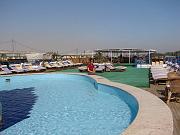
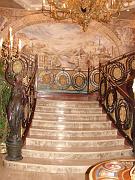
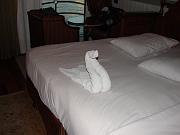
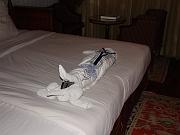

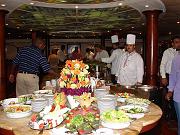

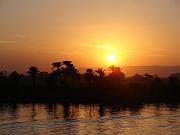
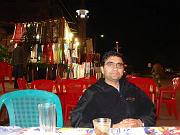
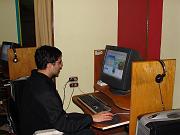

for Esna. On the way we had to cross the Esna lock, and the ship was waiting for it chance to do so. In the meanwhile we have a very unique shopping experience - vendors came by in little boats to sell their wares. From our rooms, we could easily reach out and exchange stuff with them. For those of us on the topmost sun deck in the ship, their innovative idea was to fling wares in plastic bags and we could examine them. If we liked it, we could haggle on the top of our voices and either throw money back in the bag or the wares. Since it was all duly wrapped in plastic, no damage was done. Very interesting! Breakfast on the cruise was excellent. We found easy access to the net every where along the cruise stops. We had lunch while parked at Esna and checked email there as well as tried to make some changes to our flight plans. From Esna, we sailed on to Edfu where again we checked email, had Turkish coffee and bought traditional Egyptian Galabeya garbs for a party later on the cruise. We totally relaxed on the ship the whole day reading our books, playing TT on the sun deck, having English-style tea and pastries on the deck in the afternoon, and enjoying the local scenery on both sides of the Nile. Caught a beautiful sunset on the Nile too. There was a disco party at night that we attended for a short while. All in all a well-deserved welcome break!

We had an early breakfast and went off to see the Temple of Horus - the falcon God - in Edfu. We took a horse carriage to the temple. Having ridden ghoda-gadis in India, it was no new concept for Mayur and me. But I can see the appeal for people who may not have experienced the ride before. Personally, I would have preferred to walk to the temple - get more of a feel of the town. The temple was the most well-preserved one we saw. It was built by the Greeks - Ptolemy XI and XII. The Greeks did not spend too much money on temples as they always wanted to go back to Greece and take their money with them. So usually two kings would build one temple. The reliefs in the Edfu temple are very large and extremely clear.

It had the second largest pylon after the Karnak temple, followed by 2 colonnade halls, and an inner sanctorum. This sanctorum has a black granite sanctuary with a big statue of Horus and a replica of Horus' barque. The huge pillars had beautiful lotus or papyrus engravings on the top. Christians stayed in this temple to avoid persecution so they often lit huge fires which have caused the ceilings to become black. The temple also has a Nilometer to measure the rise of the Nile and the effective taxation rate of the people. This feature is absent from Egyptian temples as the Pharaohs did not tax their citizens.

and Osiris and Nephetis. Seth married Nephetis and Isis married Osiris. But Seth was jealous of Osiris as Isis was very beautiful. So he planned to kill him at a dinner party (as the Mohammed Ali Pasha) thrown to celebrate the weddings. He made a sarcophagus to fit Osiris, and played a game that the person who would fit in it would win the sarcophagus as a prize. When Osiris tried it, Seth sealed the coffin and drowned it in the Nile. Then he also cut the dead body into 14 pieces and distributed the pieces all over Egypt. Isis got very upset and set off to look for her husband. She left her son Horus with Hathor so he had two mothers. When Horus grew up, he avenged his father's death by killing Seth. Reliefs in the temple show Horus as a bull killing Seth, Ptolemy building the temple under the graces of Horus, Horus' love for Hathor, Horus as a falcon above a lion indicating his power, etc.

We met the old hoagie who was our captain :). And saw all the engines etc which Mayur totally enjoyed watching. We saw the Kom Obo temple both by daylight as well as night, and it was quite nice by the night. This temple is dedicated to Horus and the crocodile God Sobek. The temple has two doors, and two sanctuaries for the two gods. It could have also served as a hospital as there are engravings all over the temple to that effect. We saw some mummified crocodiles too. The temple had an Egyptian calendar with 12 months, each with 30 days. The calendar shows the seasons of cultivation, flood, and harvest. It has five extra days for the celebration of the harvest. In this temple, there was a Nilometer like the Edfu temple, which was used to measure the rise of the Nile.
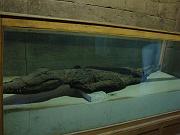
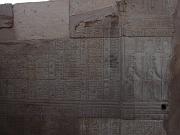

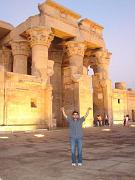

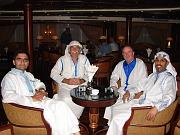
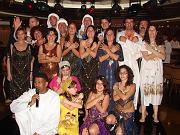
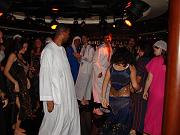
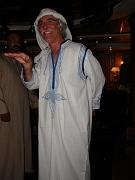

Overnight we sailed from Kom Obo to Aswan. We took an early morning flight to the temple of
Abu Simbel which is an hour's flight from Aswan. We got totally random boarding passes with our names as Martha and Andrea :). It was basically a commuter plane that people were using like a Greyhound bus. We got a beautiful view of the temple from the air and Scott took a lovely aerial shot of it. Along with seven other temples along the Nile, this temple was moved back from its original location to prevent it from being submerged by Lake Nasser when the Aswan High Dam was built. It took four years from 1964-68 and cost about $40 million. The facade of the temple is very impressive with four statues of Ramses II, although was destroyed in an earthquake in the early 20th century. Inside too, there are statues of Ramses in front of each pillar in the
colonnade hall, and scenes of his valor while fighting. The inner sanctuary has four statues - one of Ramses, and the others of Gods. These statues are fully lit only twice a year - on the
the coronation day of Ramses. Since they moved the temple, these dates were shifted by a day. Even on these dates, the fourth statue of God of darkness always remains dark. The Abu Simbel temple is located on a huge campus near Lake Nasser, and the less well-known temple in that campus is Queen Nefertari's temple. She was the favorite queen of Ramses so he built this temple for her. The facade of this temple has six big statues of her and other gods and goddesses. Inside there are scenes of Nefertari requesting Ramses to stop fighting, her being blessed by Hathor, Hathor visiting her own temple in Denadra by a boat. The inner sanctuary was totally destroyed as all the statues were completely covered in solid gold. After seeing this whole beautiful complex, we flew back to Aswan. We took a long time to make some changes to our return flight reservations and then had a quick lunch before heading out for more sight seeing in the afternoon.

built to prevent the Nile flooding to Cairo and above. Several temples were moved with financial aid from UNESCO to prevent them from becoming submerged. We then visited one of these moved temples - the temple of Isis at Philae. It is located on an island so we took a motor boat to the temple. This temple represents the event of Hathor celebrating Isis finding her husband Osiris. It was a nice small temple much like some of the other big ones we saw in the trip earlier. The Christians also built their own church there and we could see some signs of Christianity in this old Pharaonic temple. There were many smaller monuments and temples around the main temple of Isis including a beautiful birth chamber.
and therapeutic perfumes: mint, eucalyptus, lotus, papyrus, etc. And they also had the most exquisite little glass bottles to keep the perfumes in. Even a single drop of the concentrate perfume could spread a fragrance in the whole room - very nice!
After that, we saw the unfinished obelisk - after being dug, the stone was found to be too fragile and started to break. So they left the obelisk as it is. Our guide explained that these obelisks were cut from all sides and then water was poured in the cavity to lift it up. Wooden block were also used to help the process - I didn't quite get how this all worked with such a heavy piece of stone! We then took a very peaceful felucca (sailboat) ride on the Nile - it was really the cherry on the cake after the wonderful Nile cruise. Our boatman was a Nubian who are Egyptians that live in the south. They have a practice that when a couple gets married, the groom stays with the bride's family :). I totally enjoyed this ride - it was very soothing - I wished we could have stayed longer. We bought some trinkets on the boat itself - there is no getting away from shopping in Egypt! There was Nubian dance party on the cruise at night but we crashed early on itself.
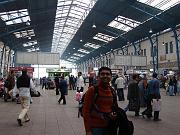

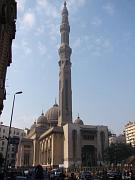


Bombay. I liked the hubhub of Cairo but the marine drive at Alexandria took my breath away. We first stopped at Pompeii's pillar which was a part of the Greco-Roman ruins. Our guide - Tamer - explained to us that all the monuments in Alexandria were destroyed due to the wars between the Egyptians, Greeks and Romans. The only thing remaining in this site was the pillar and three
other sphinx statues. We then stopped at the Catacombs very similar to the ones used by Christians in Italy to avoid persecution - unfortunately, no pictures were allowed inside. It was a huge three-storey structure completely underground; it was accidentally discovered when a local farmer's donkey feel through one of the shafts. It was completely submerged under water when Alexandria was destroyed either by a massive earthquake or a tsunami. The main shaft allows light to shine through with holes to all the mummified corpses to be passed down. The third floor is still totally submerged and has not been excavated. The architecture of this monument is totally different from the other places as it was a mix of Greek, Roman, and Egyptian architectures. Tombs are guarded by Greek symbols such as Medusa and serpents while inside the tombs we see Egyptian gods such as Anubis and Isis albeit dressed in Greek and Roman robes. Initially the catacombs were used only for a few wealthy families but then they were opened up to bury the local people too. Now we can see hundreds of niches to store as many mummies. There was one more big room in the catacombs named Carcalla Hall after a king of the same name whom the Alexandrians did not like. He had trapped many Alexandrians in one of the sectors in the city (named alpha, beta, gamma, delta, and epsilon) and killed them all. A large number of bones were found in Carcalla Hall which are believed to either belong to these people or to horses who died in the Olympic games held in Alexandria. Another interesting practice was that Roman used their bathtubs as future coffins. So they were made elaborately and when the owner died, he was just buried in his bathtub :).

After the catacombs, we visited the Qaitbay fortress located at the place of the old Alexandria lighthouse - one of the seven wonders of the word - believed to be made of solid gold and embedded with precious stones and gems. It was a legend that on a clear day one could see Greece and Macedonia from the top of this famed lighthouse. The fortress had a huge courtyard which was used for prayers as well as fighting practice. Many techniques were used in the fortress to thwart the enemies - holes in the walls to see enemies from afar, confusing corridors to mislead the enemies from the location of the main tower, large-rise steps to make it hard to climb, pour oil from the holes in the fortress walls, shoot flaming arrows from the shaft, narrow openings for archers

and canons to shoot at the enemies but not get shot back at, etc. We got simply spectacular views of the Mediterranean Sea and Alexandria (including the new library of Alexandria) from the fortress. The fortress also had a water reservoir, horse stables, dungeons, the works. We walked over to the sea and dipped our feet there. It seems that Alexandrians consider themselves different from other Egyptians; local harbor and tourism are the greatest sources of income in the city.
built in the same location (200 m away) as the ancient library of Alexandria which was the first university and research center in the whole world. It had the equivalent of 125,000 books worth of material in papyrus scrolls, only one of which survived and a copy of it is still in the new library. The original scroll is in a museum in Vienna.
The library was totally submerged in the sea and there are still 1200 pieces from the library under the sea. Tourists with licences to dive can actually see these ancient underwater pieces. They had a competition to judge the best design for the new library (just like the Sydney Opera House) which was won by a Norwegian. The library resembles a sun rising from the water modeled as a pool outside the library. Natural light is sufficient to light the whole library during the day. The outside facade of the library has lines like eyelashes to indicate that the library has eyes open to the whole world. It also has an incomplete bridge leading to the water indicating the opening up of Egypt to the knowledge of the world. All terribly symbolic! The library has the capacity to hold many many books but it is currently quite empty. It has nice exhibitions of art direction for Egyptian movies and old/imagined pictures of ancient Alexandria. A temporary exhibition showed the world's first printing presses. The library also has the eighth largest planetarium in the world.

and had authentic Egyptian food. Tamer dropped off us at the station and reached Cairo after a couple of hours. We got this super fancy suite in the Sheraton for the night with a Nile view but sadly I hardly had an hour there before I had to head back to the airport. We got lovely view of Cairo city by night from our room. Mayur and I sat in the patio for some time soaking in the view and spending our last little time together - we were to meet after a long month after that. Hossam dropped me off to the airport and I flew in to Bombay and Mayur flew back the next day to San Francisco. I doubt if we will go back to Egypt but we had a great time and its a must-see for all history buffs and otherwise too :).